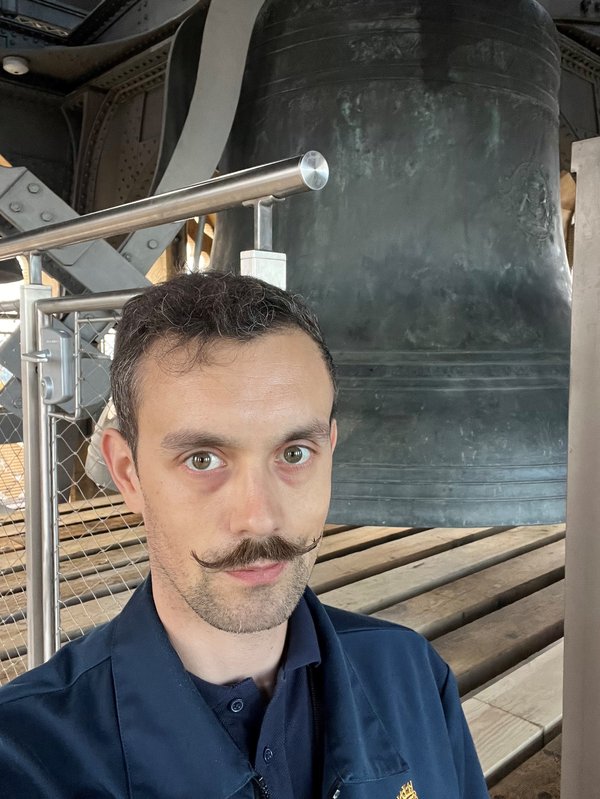The AHS Blog

Time symbols in St John’s Co-Cathedral, Malta
This post was written by Peter de Clercq
As he knows that I am interested in horology on gravestones (see my earlier blog ‘Time symbols in cemeteries’ posted in October last year), Anthony Turner kindly sent me a few photos taken during a recent visit to Malta.
In St John’s Co-Cathedral in Valetta, the floors are entirely paved with inlaid marble tombstones of the knights of St John. They were all made following original designs and composed of coloured inlaid marble. They date from the early seventeenth century to the late eighteenth century.
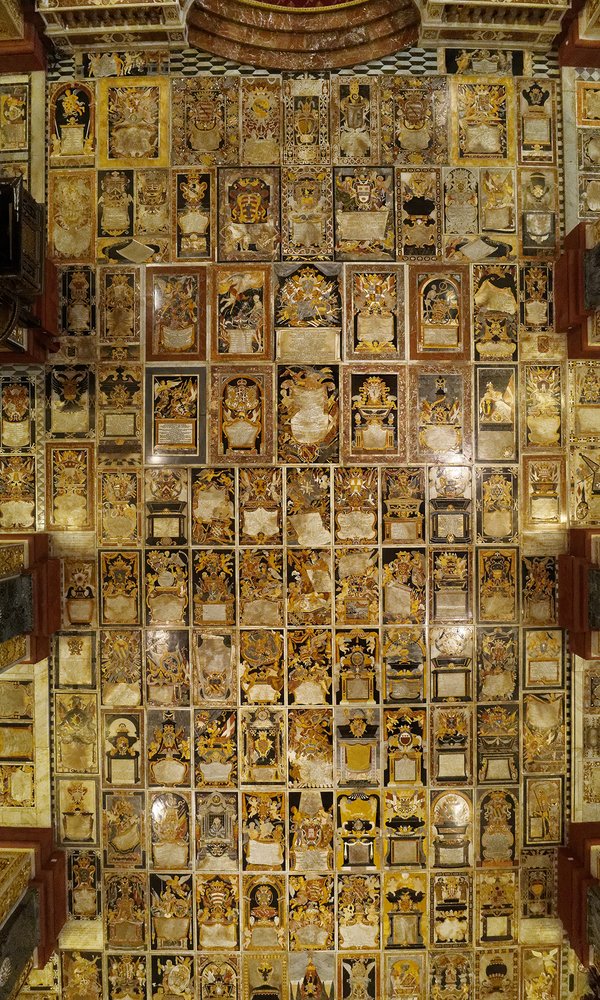
The in total 405 tombstones and monuments, of which 154 are in the main nave, are all illustrated on the wonderful website of the Co-Cathedral. There we learn that they commemorate some of the most illustrious knights of the Order. Several of them were members of powerful aristocratic families of Europe. They were grand priors, admirals and bailiffs, amongst others, and were often referred to as Most Illustrious Lord Brother Illustrissimus Dominus Frater.
The Latin epitaphs describe the virtues of the individual knight. Each tombstone is charged with messages of triumph, fame, victory and death. Symbols, both ecclesiastical and profane, are used in a vibrant visual language of colour and design.
One of the most popular symbols is the image of death represented by a skeleton, often with a sickle and an hourglass, and occasionally a clock or clock dial, all signifying the passage of time. Here are some striking examples.
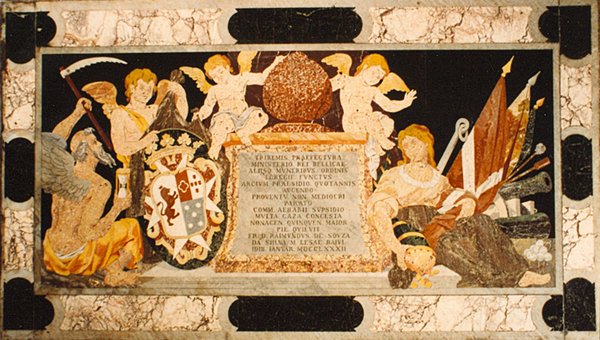

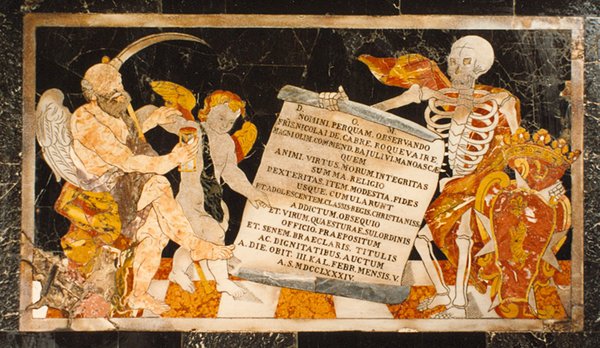


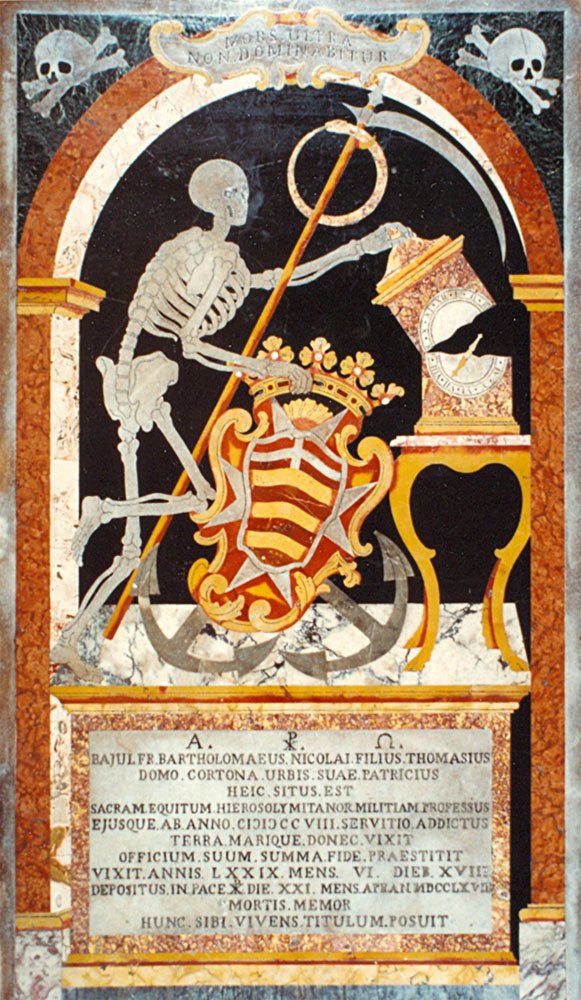
If you ever have the chance to visit Malta, do not miss St John’s Co-Cathedral. Anthony assures me it is quite spectacular.
All photos reproduced here courtesy of St John’s Co-Cathedral.
Stop all the clocks – a murderous take on the subject
This post was written by James Nye
Albert Johnson Walker, a Canadian, was born in 1946. In the 1980s, he defrauded his clients of millions of Canadian dollars. He abandoned most of his family and moved to Europe, ending up in Harrogate, Yorkshire. In 1993, he was charged in Canada, in absentia, with 18 counts of fraud, theft and money laundering. In time he became one of Canada's most wanted criminals.
Covering his tracks, Walker changed his name to David Davis, and set up a new business with a television repairman called Ronald Joseph Platt. Back in 1967, Platt, a 22-year-old Englishman in the Army, bought a Rolex Oyster Perpetual in Osnabruck, Germany, serial number 154402.

Fast forward to the 1990s again, and Platt ran out of money. Walker suggested emigration to Canada and a new life. Walker bankrolled Platt’s trip, but claimed he needed Platt's driver's licence and birth certificate to keep the UK business running. Once Platt was off the scene, Walker assumed his identity. So, he’d started as Walker, changed to Davis, and now he was Platt.
The real Platt ran out of money in Canada and returned to England in 1995, inconveniently for Walker (now calling himself Platt). Walker took Platt on a fishing trip on 20 July 1996 where he probably knocked him out with a heavy blow to the head, then weighed him down with an anchor and dumped his body in the sea.

Two weeks later, the body was discovered in the English Channel. The only identifiable object on the body was the Rolex watch – with its crown duly screwed down tight. It showed the time as 11.35 and a calendar date of 22. Enquiries with Rolex revealed the location of the serial number, hidden by the strap. Rolex confirmed the name and address of the owner, and the watch's service record for the 1980s.
With Platt’s identity established, investigations inexorably led to other people associated with him – including Walker, now masquerading again as David Davis. A GPS fix for Walker’s boat tallied with calculations for when the watch's power reserve would be exhausted. Walker was apprehended shortly thereafter. In 1998 he was tried and convicted for murder. Without the watch, the murder would have gone completely unsolved.
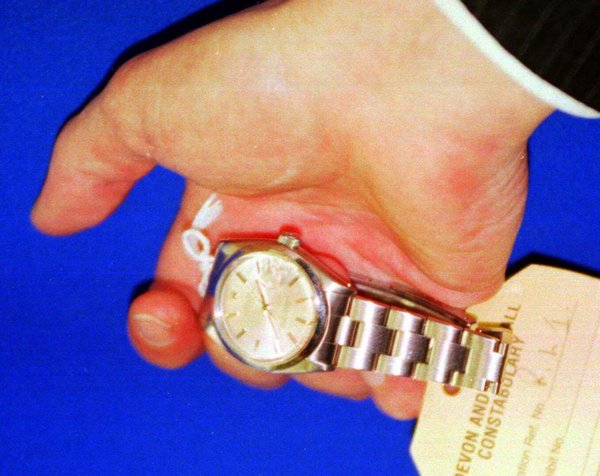
Vorwarnschlag – or signalling the arrival of the hour
This post was written by James Nye
A few of us travelled to Transylvania, Romania, in early March 2025. We were hosted by a local contact and friend, Dragoș Poponea, who guided us around an amazing array of fortified Transylvanian Saxon churches, often equipped with turret clocks from makers in Germany or the former Austro-Hungarian Empire (e.g. at Biertan, see image below).
Dragoș has the care of many of these church clocks, a huge task in a region where the Saxon population largely abandoned their long-term homelands in the wake of the 1989 revolution. Communities that could once purchase a top-of-the-range Mannhardt ‘freischwinger’ clock from Munich (or similar) have disappeared, and the resources to maintain such wonderful devices are now scarce.
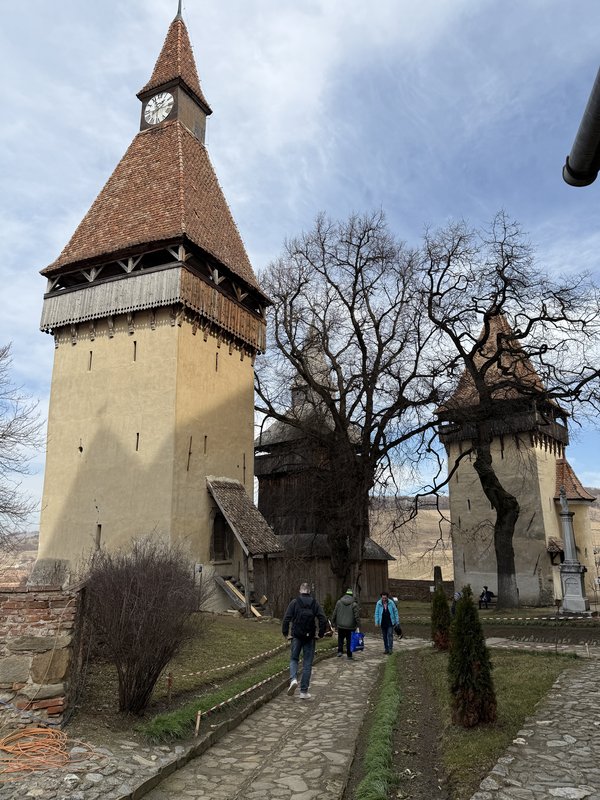
Climbing around dusty towers and getting ourselves magnificently filthy, we were delighted to discover something new to all of us. Indeed, even for our friends who are experts in Germanic turret clock horology, this was something perhaps heard of, but not witnessed.
In a handful of churches, Dragoș opened our eyes to hour-striking turret clocks, with a third train that did not strike the quarters but instead provided a warning of the impending hour.
In Germanic dialects, this train provides a ‘vorschlag’, or ‘weckschlag’, or perhaps most accurately ‘vorwarnschlag’, which we might translate as ‘forewarning alarm’. Prior to knowing the Germanic terminology, the British team landed upon ‘hour-signalling’ to describe the feature.
Just before the hour, this ‘hour signalling train’ is let off. By one of several different techniques it is designed to make a bell strike rapidly. An alarm call, effectively. The end of the alarm leads to the hour-striking train being let off, which will then sound on a much larger and deeper bell. The function is simple. ‘Pay attention everyone! We are about to sound the hour. Listen up so you count the correct number!’
There are variants in the way the alarm call is achieved. One type involves using two hammers to strike a fixed bell, while the other swings a smaller bell so that its clapper operates.
With the fixed bell type, one very clever arrangement involves just one pinwheel, which acts on a two-part lifting lever (e.g. at Roșia).
The first part of the lever to be lifted will begin to lift one hammer, but will also, with a small mechanical delay, lift the second part of the lever, which is connected to the other hammer.

Since the two hammers have been lifted to different heights, when they are released they can strike the same bell (even the hour bell), but with successive blows.
With the swinging bell type, the arbor on which the bell is mounted can be swung to and fro by wires attached at the ends of a cross-piece fixed to the arbor.
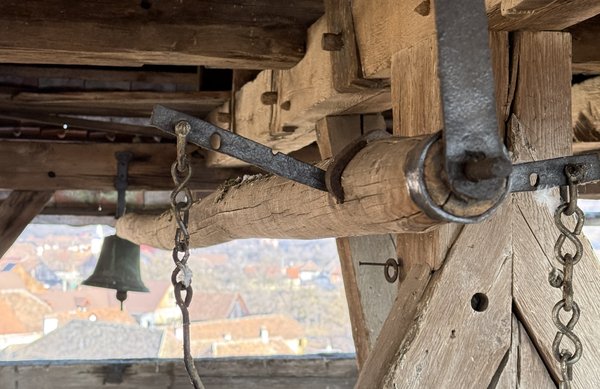
The two hammers can be actuated by a double pinwheel with two sets of lifting pins acting on two lifting levers, one for each hammer (e.g. at Cincșor).
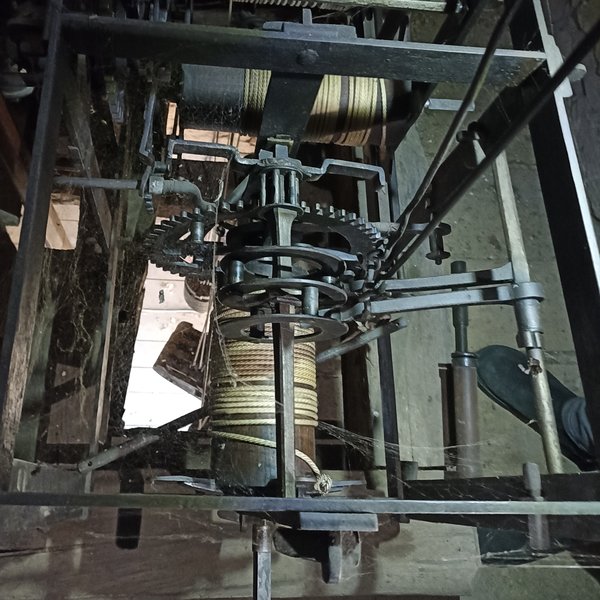
However, in a more elegant arrangement, the circular motion of a wheel is converted, via a crank and forked lever, to a reciprocating action, thus pulling the two wires successively to swing the small bell (e.g. at Șelimbăr). For a video, click here.

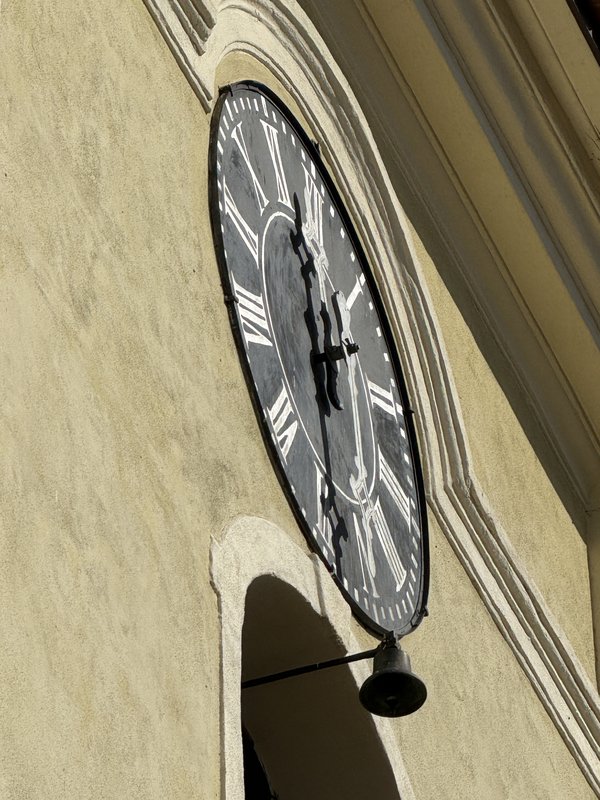
There may well be more variants. All of this was very new to us, and hugely interesting. There is clearly a strong tradition in the rural and agricultural Transylvanian Saxon region to signal to the population that the hour is coming.
The system is reminiscent of the idea employed in clocks from the Comptoise region of eastern France where the hour is struck twice, two minutes apart, to give the listener a chance to ‘hear again’ the hour, but the Transylvanian ‘hour signalling’ surely provides a clearer message.
It’s about time we learned a bit more about such a sensible tradition.
Patenting precision: early motorsport timekeeping
This post was written by Marie Reber Ondrejikova

An advertisement dated 29th January 1881 in the New York weekly The Spirit of the Times proclaims that: ‘a gentleman not only secures a timer for the track, but also an excellent watch for ordinary purposes, that will last him a life-time. The timer beats fifths of seconds, which is admitted to be the most accurate movement’.
The watchmaking workshop founded by Auguste Agassiz produced its first movements under the Longines name in 1867, and in 1879 brought to market its first chronograph movement, the calibre 20H. Although this calibre did not include a minute totaliser, it established the Longines name on American racecourses.
In these early years the focus was on horse racing but by 1886, Longines was already equipping the majority of sports judges.
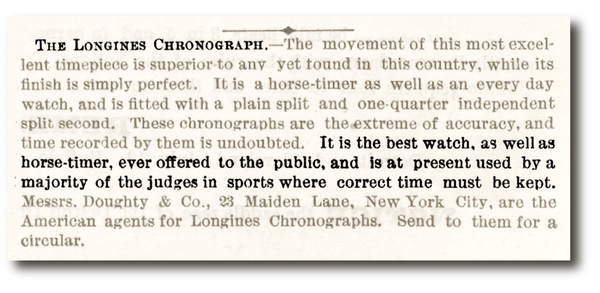
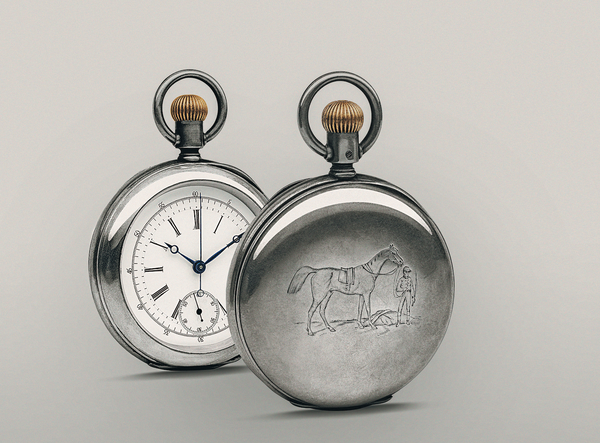
In 1889, Longines developed its second chronograph, the calibre 19CH, followed by increasingly sophisticated chronographs such as the calibre 19.73 in 1897, capable of measuring times to one-tenth of a second and intermediate times.
These technical advancements were well timed, with the first automobile race in the United States taking place in 1895.
The early motorsport races were spectacular events. The public were thrilled by the courage of the drivers and admired the beautiful machinery, still rarely seen on the roads. These competitions played an important role in the development of the automobile and in improving the performance and reliability of vehicles.
As motor cars gained popularity and speeds increased, new sporting events emerged alongside professional timekeeping. In 1910, Longines filed patent CH49005 for an electric control device for a pocket chronograph. This patent was of particular importance in the field of motor sports timekeeping, as it explicitly specified that the invention was intended for the velocipede and automobile disciplines.
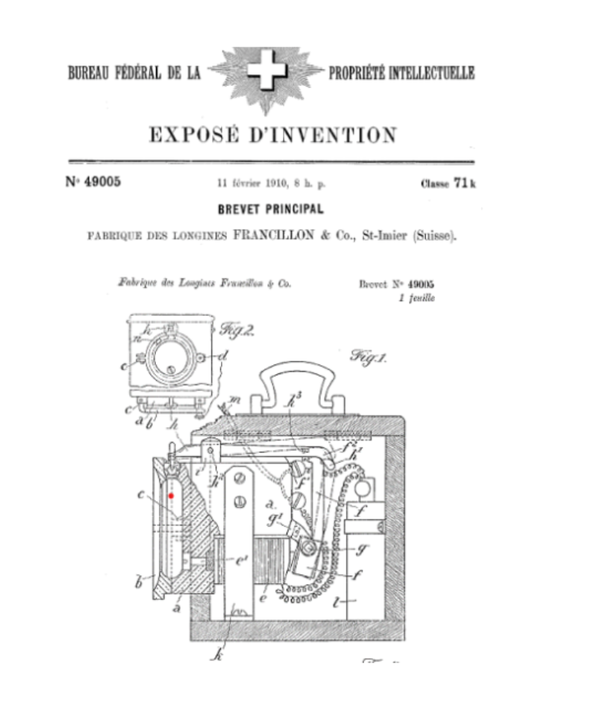
In addition to this patent, in 1910 Longines also filed a patent for a chronograph counter displaying time to the tenth of a second (patent no. 50389), an innovation that required a high-frequency movement with 36,000 vibrations per hour.

These early patents laid the foundations for the very first sports timekeeping service, adding cutting-edge electrical skills to watchmaking know-how, and the creation of timekeeping control systems.

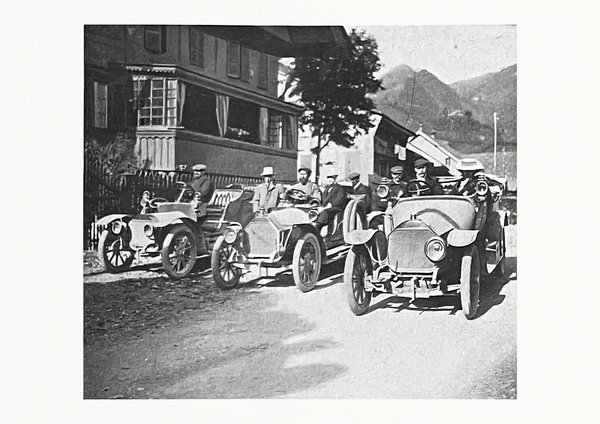
An eighteenth-century wind-up
This post was written by James Nye

Perhaps an AHS blog post is an unusual place to find literary criticism, but the recent death of Dr Bill Linnard, a much-loved horological scholar, calls to mind his treatment of a risqué horological joke at the opening of Laurence Sterne’s Life and Opinions of Tristram Shandy (see Horological Journal April 2014, pp. 174–5).
The narrator, Tristram, describes his father as a man of unshakeable and timely habits, winding ‘a large house-clock, which we had standing on the back-stairs head’ on a monthly basis, and, we are to infer, making love to Mrs Shandy on a like schedule. At the moment of Tristram’s conception, the earth does not move as expected: ‘Pray my Dear, quoth my mother, have you not forgot to wind up the clock?’
The book seemingly met with general outrage owing to its saucy content. As Linnard noted, the Clockmakers’ Company and the wider horological trade were apparently among the most offended, a small group of them publishing The Clockmakers Outcry Against the Author of the Life and Opinions of Tristram Shandy (J. Burd, London 1760).

In this pamphlet we learn that sex-workers in London had come up with a new opening gambit. ‘Nay, the common expression of street-walkers is “Sir, will you have your clock wound-up?”’ As a result, clocks had become taboo and orders were cancelled, much to the chagrin of the trade. Timepieces were now viewed ‘as obscene lumber exciting to acts of carnality’.
Bill Linnard described the pamphlet as a spoof, but many conclude that Laurence Sterne himself was the author, engaged in a tradition of puffery by publishing criticism of one’s own work – there being, after all, no such thing as bad publicity. We can be confident the clockmaking trade did not actually suffer at all, and there is, rather regrettably in retrospect, no other known reference to gentlemen being asked if they wanted their clock winding.
OK. We can see through Sterne’s elaborate artifice in stirring up further interest in his own work, but what was his inspiration? This is the question we clockmakers need answering. Why might Sterne have delved into the world of clockery, and on such a bawdy basis?
A possible answer lies in his friendship with William Hogarth, who provided illustrations for Tristram Shandy. As Patricia Fara amply demonstrated in her AHS London Lecture on ‘Hogarth: Time’s Artist’, in January 2023, the imagery and symbolism of clocks were subsumed throughout Hogarth’s work. Clocks were part of an attempt at rationalisation and control, but also stood for the frailty of humanity. Hogarth was also no stranger to conjuring images of the seedier side of life.
A month-going clock was no common item in the mid-eighteenth century – it was an expensive luxury, or a natural accessory for an enlightened gentleman, a sort of exquisite machine to bring order amid potential chaos. Someone close to Sterne had one, we have to assume. And since it was in his nature to satirise or parody such attempts to impose control, the clockmakers came in for some unlucky wind-up humour.
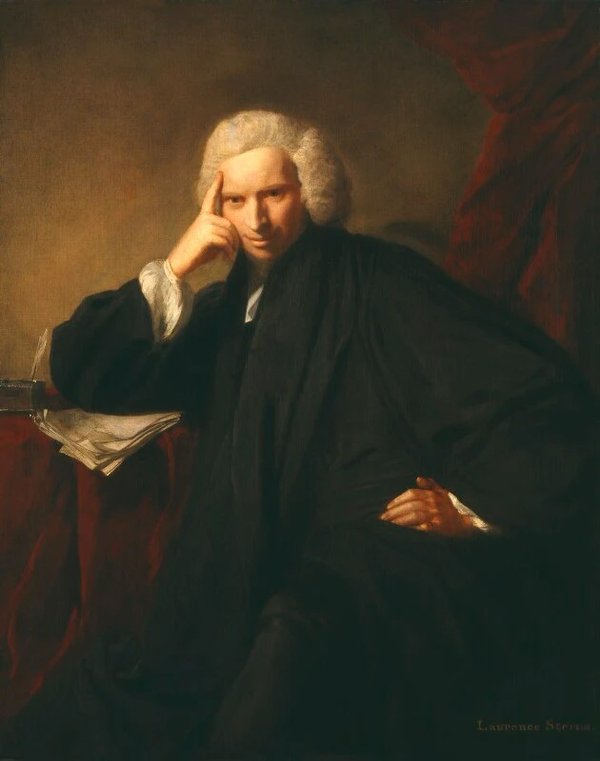
Playing card packing pieces
This post was written by Tobias Birch
As some of you might know I am passionate about Thomas Mudge. So in June 2023 I was delighted to be invited by the curator of horology at the British Museum, Oliver Cooke, along with esteemed horologists Andrew King and Jonathan Betts, to look at two Mudge clocks, the Lunar Mudge and the Polwarth Mudge.
Jonathan was researching for his upcoming talk to the AHS, 'The Technical Legacy of Thomas Mudge'. While inspecting the ebonised case of the Lunar Mudge, a case that is, I believe, the beginnings of the three pad top style case table clocks you see in the second half of the eighteenth century, I decided to remove the seatboard. You never know what you might find!
On removing the seatboard, made more involved as one had to first remove a brass carrying handle, the effort was soon rewarded.
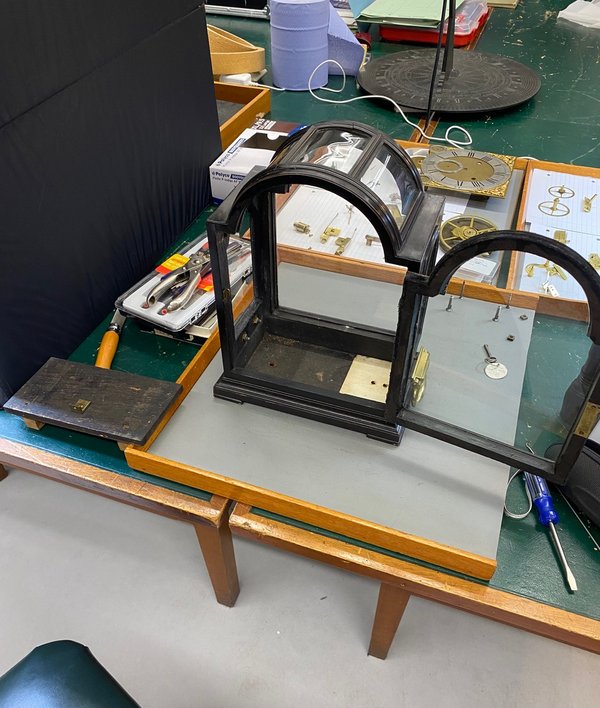
To all our surprise, hidden beneath the seatboard I found some playing cards, and not your everyday, free in Christmas crackers playing cards. They were a well preserved hand-painted Queen of spades and a five of hearts. Most likely eighteenth century playing cards.
The cards were placed under the seatboard, as convenient packing pieces to raise the movement slightly, probably when the clock was originally made in the 1750s. After photography I placed them carefully back in the position from where they came.
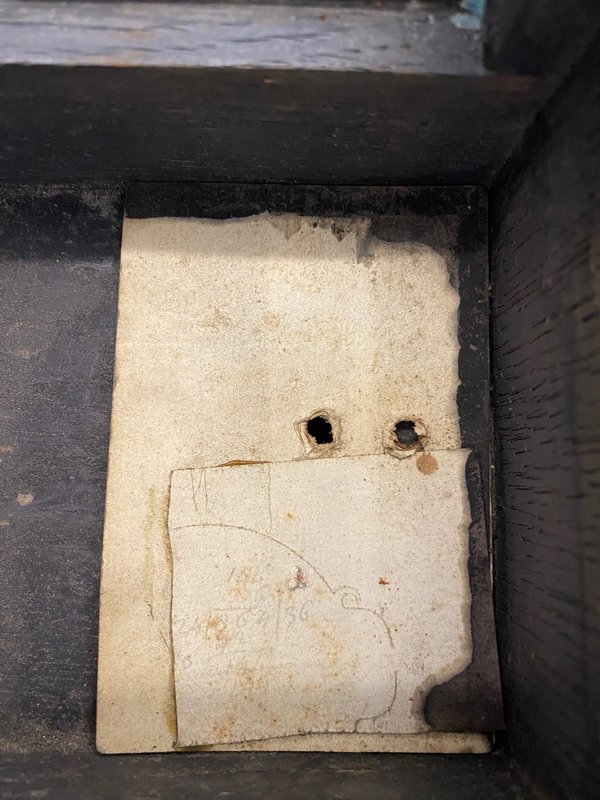
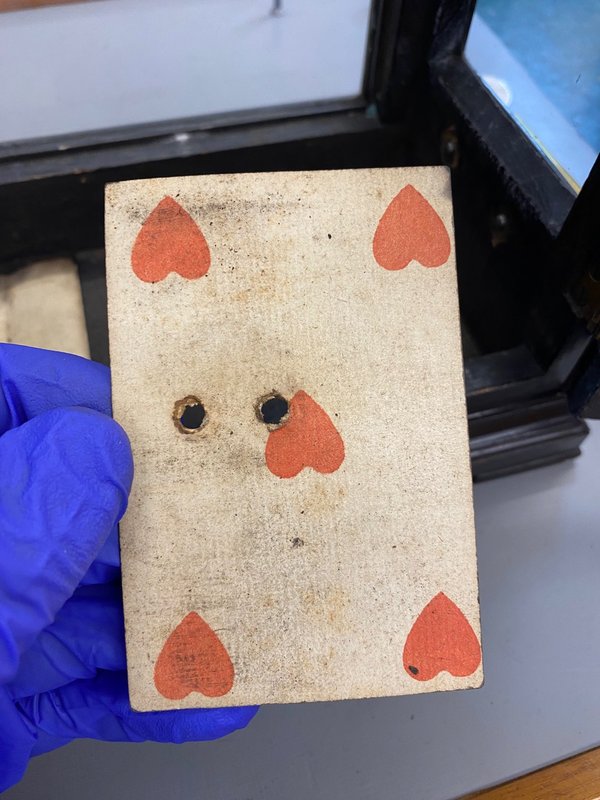

This was the first time in over 30 years of working on clocks that I had seen playing cards used in this way, and I didn't expect to see it again. Yet, less than a year later, while working in my own workshop on a Thomas Mudge and William Dutton table clock of the three pad top style that I mentioned earlier, made around twenty years later than the Lunar Mudge, I once again did my usual practice of removing the seatboard. This was more easily done this time, as there was no handle to take off first.
You have no doubt guessed what I found.
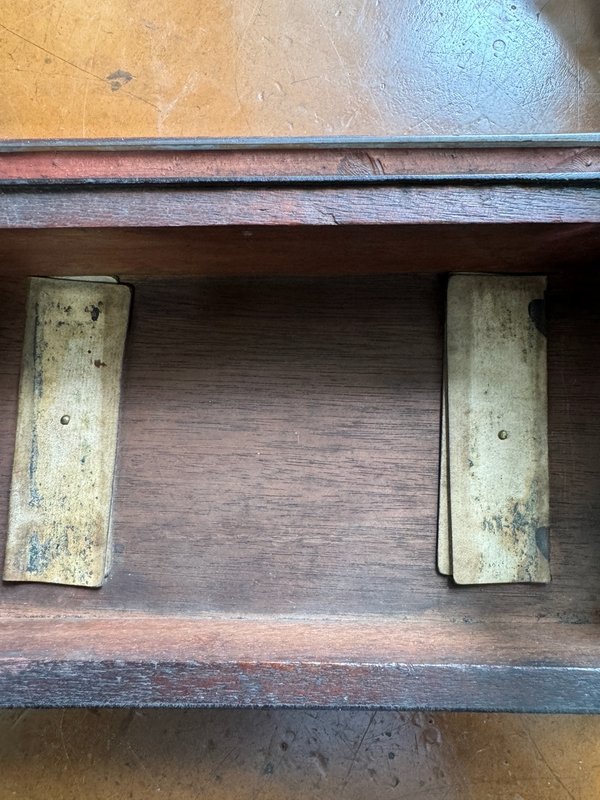
Here the cards were folded over and held in place with small round head brass nails. The left card was too indistinct to make out the suit, the card on the right is a two of spades. Again, hand painted on similar colour card as the Lunar Mudge cards.
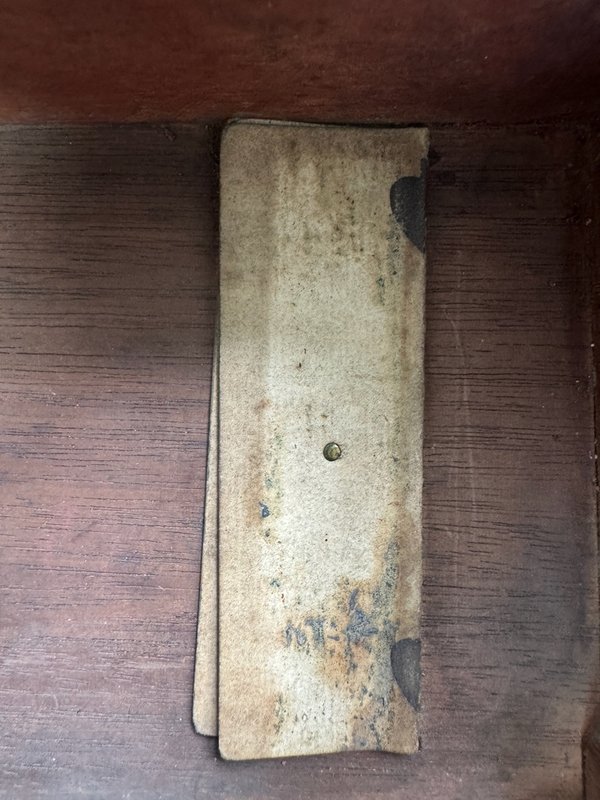
I would be interested to hear from anyone that has found similar playing cards placed under seatboards of table clocks. Perhaps there was an avid card player in the Mudge workshops and they used cards from incomplete decks they had lying around? Or perhaps they used cards from a deck that had proved unlucky and they no longer wanted to play with?
We will never know, but I liked the link back to an individual, long gone, whose work survives and who, if I were to somehow meet, would, I imagine, have plenty to talk about.
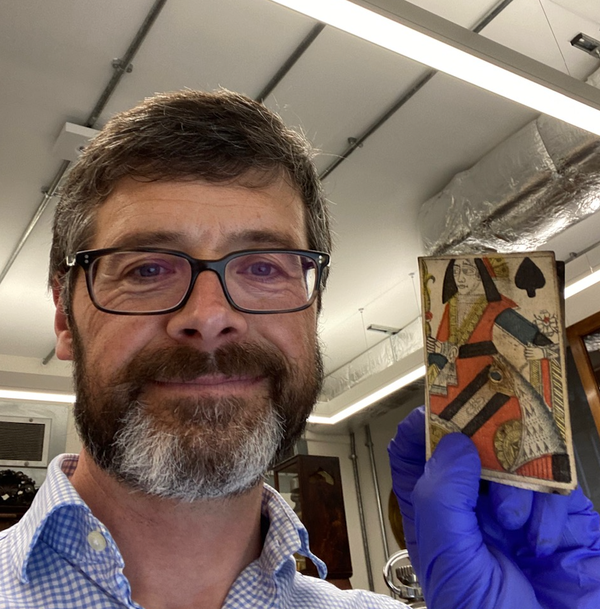
Time symbols in cemeteries
This post was written by Peter de Clercq
My wife and I like to visit cemeteries. To some this may seem a morbid pastime, but we value their tranquillity, and appreciate them as a kind of open-air museums where we see how our ancestors commemorated their dead.
In Lisbon is the enormous hillside Cemitério do Alto de São João (Height of St. John Cemetery), overlooking the river Tagus. Opened in 1833, this vast necropolis is mostly filled with family tombs and mausoleums, lining what they call ‘ruas’, ‘streets’.

On gravestones and funerary monuments, you often see the hourglass as an emblem of mortality, a symbol of the passing of time. Often there are wings at the sides, reminding us that time flies and eventually will run out for all of us.
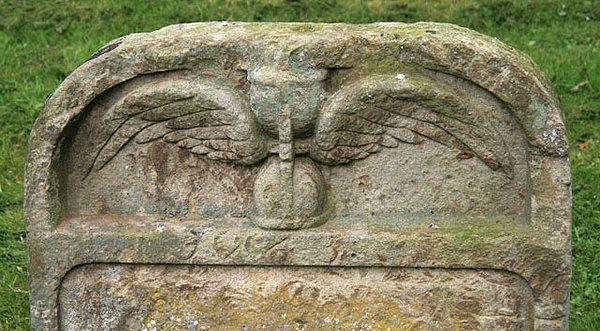
The Cemitério do Alto de São João contains many examples of these winged hourglasses, often in combination with other symbols of death, such as the scythe of Father Time, an inverted torch symbolising the extinction of the flame of life, or a skull and crossed bones.


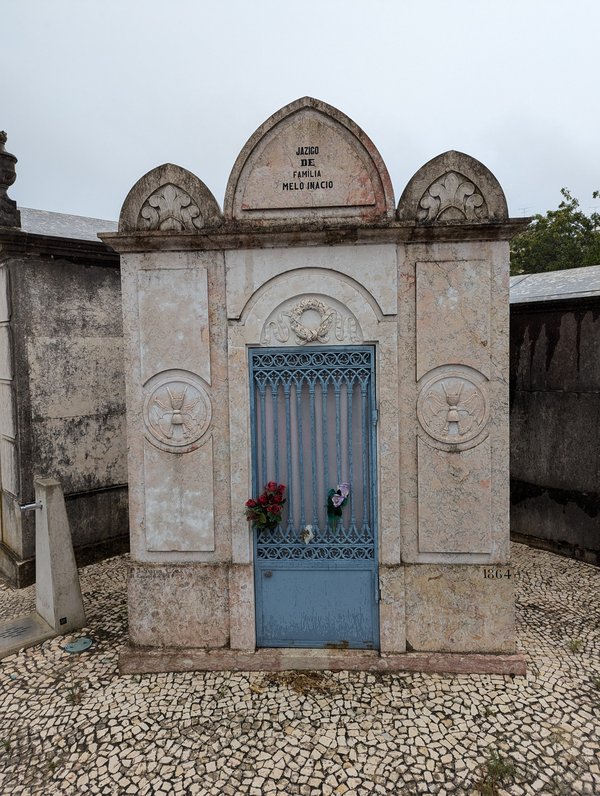


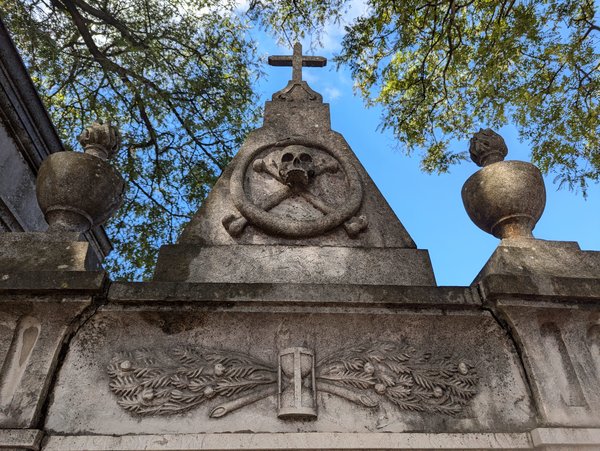
An hourglass is also depicted on a cast-iron funerary monument erected in 1832 on a Dutch cemetery, together with an oil lamp, symbol of eternal life, seen standing on a book on the right. The lamp is also shown prominently on a design drawing for this monument and there are also inverted torches on the monument, as can be seen here.
The hourglass and the lamp are mixed in with an elaborate ensemble of scientific instruments (a single-plate electrostatic generator, with a Leiden jar and a discharger in front, a telescope, and three drawing instruments), which commemorate that the deceased man had a strong interest in the natural sciences, and owned his own collection of scientific instruments.
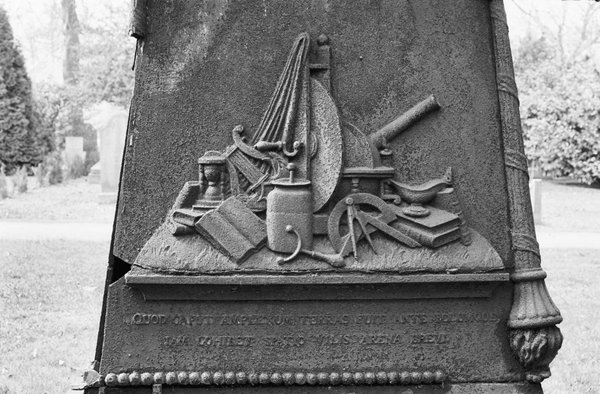
On a printed invitation to attend a funeral, dated 1712, we see three hour glasses, one of them winged. But there are also, in the bottom corners, two clocks, another reminder of the passing of time.
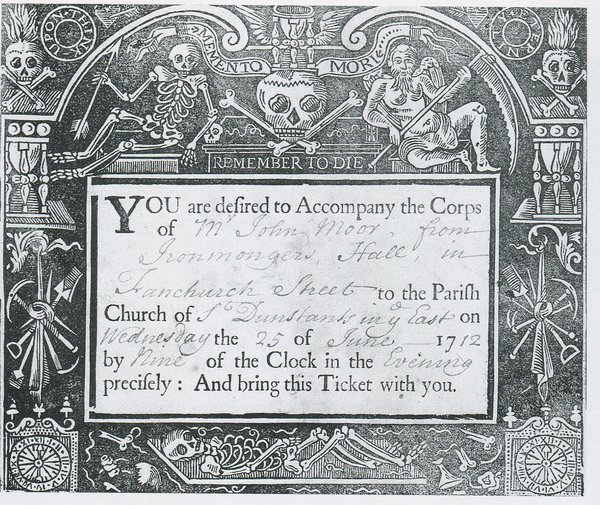
On our visits to cemeteries, we have only once found a clock depicted on a gravestone, where it was part of the instrumentation of the deceased, the German astronomer C. L. C. Rümker (1788–1862). This was also in Lisbon, in the British Cemetery, and it was shown in an earlier blog, Clocks in Lisbon.
But in the Cemitério do Alto de São João we found something we had never seen anywhere else: the depiction of a clock dial.
The hands are in the classic ‘10 past 10’ position, and the dial is accompanied with a sobering text that translates as ‘The hours go by / the days go by / the years go by / and our lives go by’.

And as if that were not clear enough, at the bottom is again the winged hourglass.
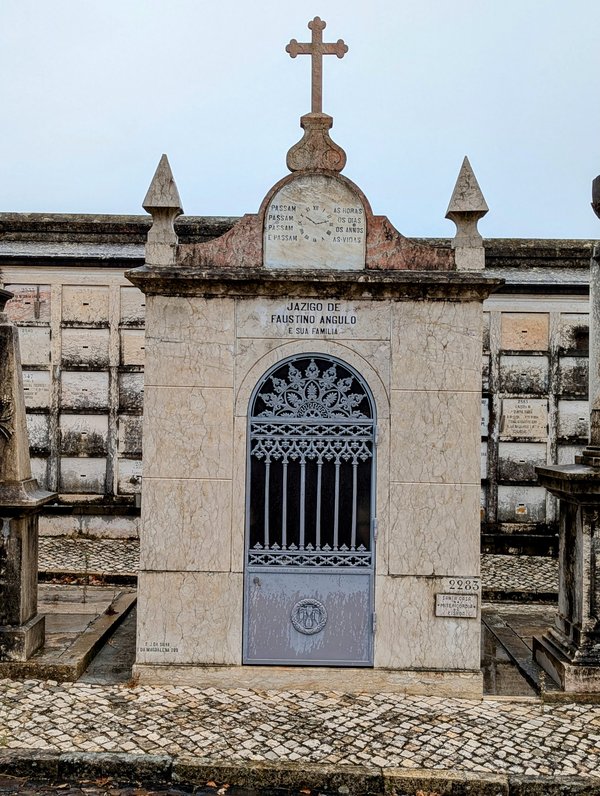
Unless otherwise stated, photos by Jade de Clercq.
Who was Master Humphrey?
This post was written by James Nye
Sometimes I'm asked about my lifelong obsession with clocks and what on earth I see in them – or perhaps what they say to me.
In reply, I'll comment about their longevity and the fact they tend to last longer than people. I'll observe that they tick out the lives of those around them – that they are observers in whom the events they witness become inextricably bound up.
And I'll say that sometimes, when we are researching or writing about those subjects, our clocks help us along with helpful nudges and hints.

It pleases me to know that Charles Dickens had something of the same sense. In Master Humphrey’s Clock (1840), the eponymous timepiece is imbued with the same timeless and comforting qualities.
Discussing the work with a friend, Dickens describes a quaint old character who has a great affection for a clock:
"He has got accustomed to its voice, and come to consider it as the voice of a friend […] its striking in the night has seemed like an assurance to him that it was still a cheerful watcher at his chamber door […] its face seemed to have something of welcome in its dusty features, and to relax from its grimness when he looked at it from his chimney corner."
Not very practically, Dickens had the notion that the trunk of the clock could be a safe repository for the manuscripts of a club that would meet to read to each other. He says:
"I mean to tell how that he has kept his old manuscripts in the old, dark, deep, silent closet where the weights are, and taken them thence to read (mixing up his enjoyments with some notion of the clock), and how, when the club came to be formed, they, by reason of their punctuality, and his regard for this dumb servant, took their name from it."
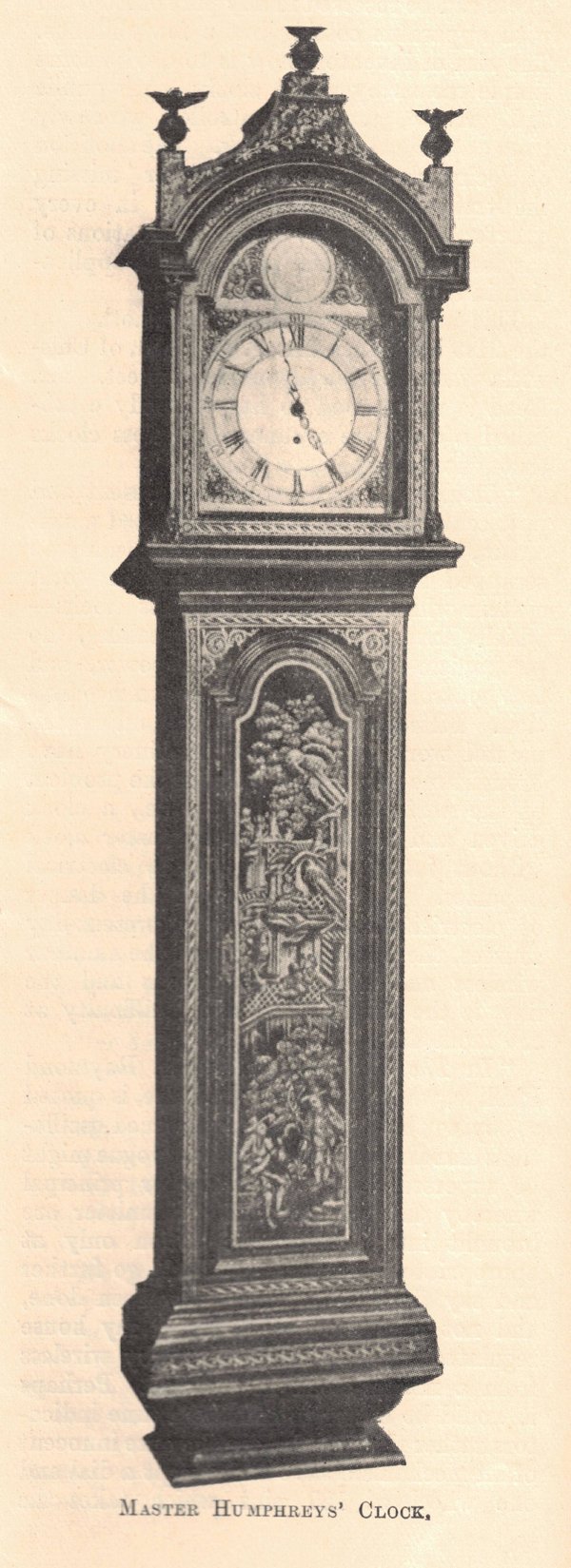
The Horological Journal of October 1912 (available online to AHS members) carries a pleasing account of Dickens’s inspiration.
In 1837, Dickens spent several weeks in Barnard Castle, Yorkshire, researching school conditions for Nicholas Nickleby. While there, he encountered a clockmaker named William Humphreys.
In 1828, Humphreys had acquired an ornamental seventeenth-century Dutch longcase clock with a worn-out movement. The following year, having fitted it with a new mechanism, he installed it in a niche to the right-hand side of his shop door.
This was the real "Mr Humphreys' clock," consulted occasionally by Dickens on his local journeys. He came to know not just the clockmaker himself but his son, Master Humphreys. In Dickens's mind, "Humphreys" became "Humphrey," and thus was born the inspiration of his 1840 work.
And as I type, I am accompanied by a comforting tick from a shelf just beside me. If I wait a few more minutes, I will be reminded of the hour...
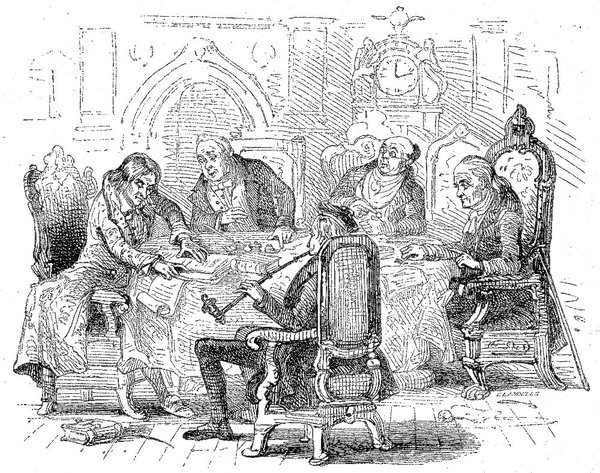
To Gaddesden (on the trail of a turret clock, part 2)
This post was written by Dale Sardeson
In a recent post, On the trail of a turret clock, I began an account of my search for a clock by Allam & Caithness. Informed by the Thwaites archive transcription and investigation project that James Nye and Keith Scobie-Youngs have been working on, the trail led me to St. John-the-Baptist church in Great Gaddesden, Hertfordshire.
The website of the church reveals that indeed, their clock was given to them by Gaddesden Place in 1955.
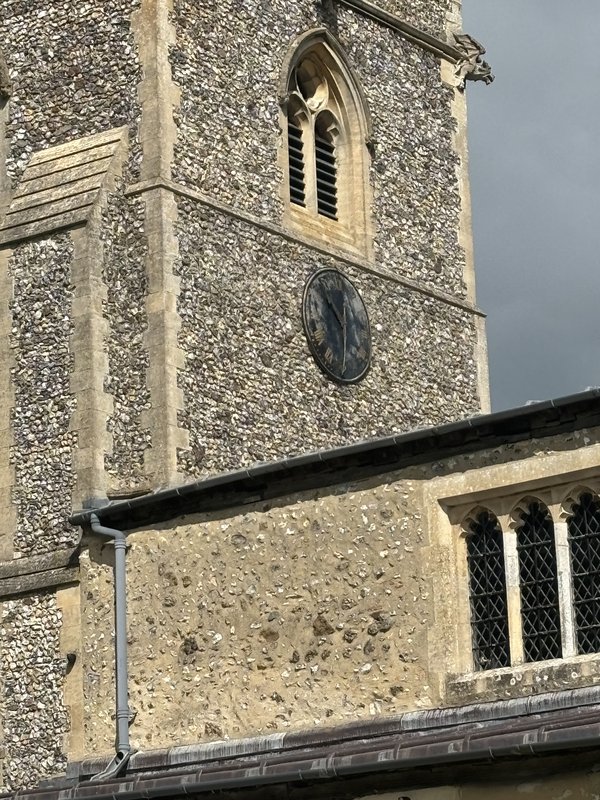
Another pointer from James Nye directed me to the website of Gaddesden Place, a house no longer in the Halsey family. From there I made contact with the current owner, who directed me to the following two photos of the North Wing, taken in 1898 and 1926 respectively. You can certainly make out the shape, if not the detail, of a clock dial above the main entrance to the wing.
The wing was demolished in 1955 owing to dry rot, and it was then that the clock was given to the parish church, with which the Halsey family have a long and close relationship.


I arranged a visit to the church, and one of the wardens, Peter King, kindly showed me into the tower. I was able to have a good look at the clock. It is an example of what Keith Scobie-Youngs has described as Thwaites’s ‘Ford Model T’ of turret clocks, with rack striking, gravity-arm maintaining power, and a recoil escapement with steel pallets affixed to a cast brass pallet frame, all housed within Thwaites’s characteristic green frame. It is signed for Allam & Caithness on the setting dial.
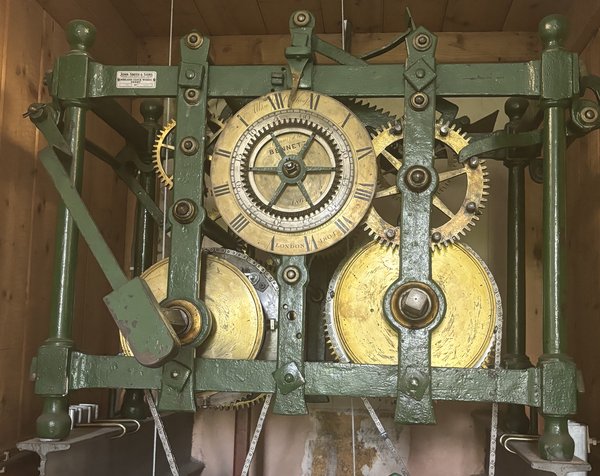
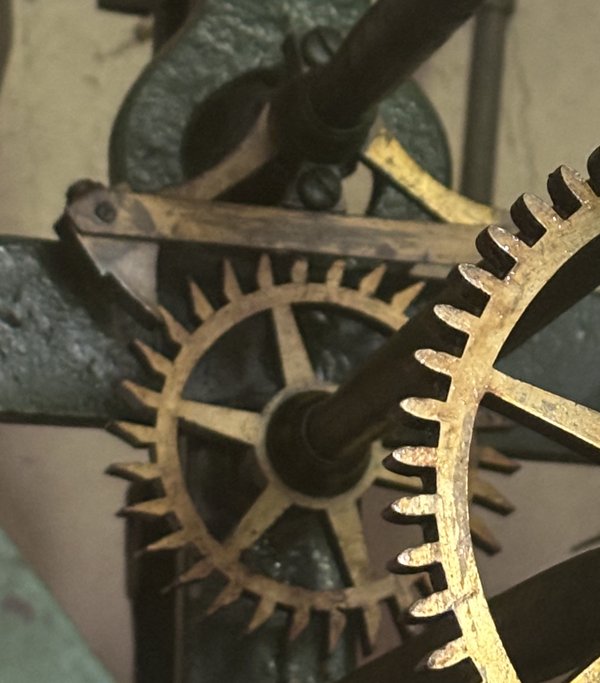
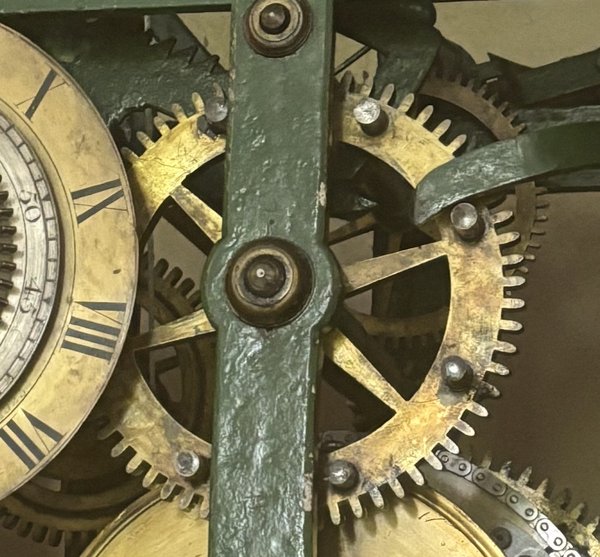
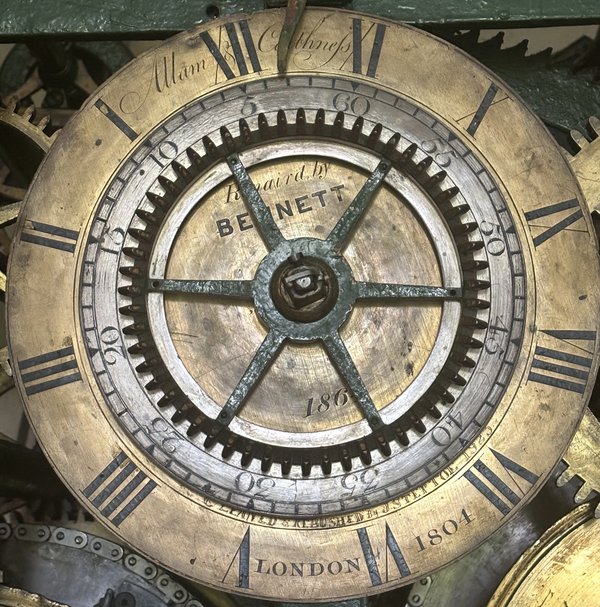
Besides the features of its construction, looking at the clock in person allowed me further glimpses into its history.
There are two inscriptions on the setting dial: ‘Repaird by Bennett 1864’, and ‘Cleaned & rebushed by J Steptoe 1925’. The latter would almost certainly be James Steptoe of 67 High Street, Hemel Hempstead, found listed as a watchmaker in a number of Kelly’s Directories for Hertfordshire through the late nineteenth and early twentieth centuries.
Bennett, however, is harder to place, being such a common name. It would be tempting to think it could have been Sir John Bennett of Cheapside – after all, it was a London firm rather than a local one whom the Halsey family had first commissioned for the clock’s supply. But there were several Bennetts in London it could have been at that time.
There is also a John Smith & Sons service plaque from 1955, so it appears it was they who carried out the installation of the clock into its new location at the church. Smith of Derby have continued to be involved in the care of the clock, fitting it with autowind units in 2016.
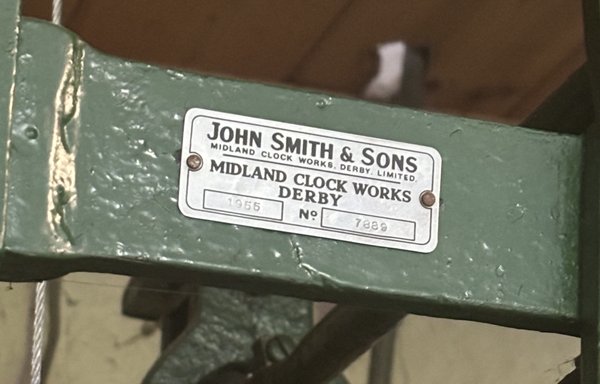
It is quite a joy to be able to trace a clock from its original written estimate right through to the present day, and I can’t wait to see what other stories have been revealed from the Thwaites Daybook project!
Unfriending in the eighteenth century
This post was written by James Nye
Recently, AHS member Jeremy Evans, a highly distinguished former horology curator at the British Museum, donated a remarkable archive of research papers to the Society. It was amassed over a long career and fills four metres of shelves at our Lovat Lane headquarters. It was most generous of Jeremy, and we were delighted to receive it!
While waiting for the papers to be catalogued by our Archivist, Dorota Pomorska, I decided to have a bit of a delve. In an index of horological articles that Jeremy had found in eighteenth-century newspapers, I noticed the entry ‘Matrimonial Strife’. Curious, I looked further.
Usually, during a male clockmaker’s life, his wife is invisible in the historical records. Sometimes, though, these women do make appearances. Elopement could be the cause. It is now customary to think of elopement as the young running away to marry without parental consent. Yet in the eighteenth century, married women also eloped – from their husbands. Sometimes this was with a lover. The word could also mean ‘escape’.
In a world of sexual inequality, women had few options. Maureen Waller, in her work The English Marriage: Tales of Love, Money and Adultery (John Murray, 2009), wrote, ‘On her wedding day, a woman stepped into the same legal category as wards, lunatics, idiots and outlaws’.
One reason why women left their husbands was domestic violence. Abuse of a spouse is well-exemplified in the cruel treatment meted out to Dorothy Arnold by her husband John, of chronometer making fame and usually a horological hero, detailed in Martyn Perrin’s article ‘The secrets of John Arnold, watch and chronometer maker’ (Antiquarian Horology, June 2015).
In other cases, we do not know the underlying reason why women left their husbands and can only speculate.
In Jeremy’s archives was the following list of horological escapees:
- Sarah the wife of William Gibbs of Upper Moorfields, clockmaker (Daily Advertiser 27 June 1741).
- Mary the wife of Edmund Pottecary, clockmaker, of […] St. Andrew Holborn (Daily Advertiser 6 August 1745).
- Sarah, the wife of Thomas Linter, watchmaker of Cripplegate (Daily Advertiser 6 August 1746).
- Elizabeth, the wife of John Simmons, watch-case maker in St Bartholomew’s the Great (Daily Advertiser 11 September 1746).
- Thamisian Symonds, wife of John Symonds, watch-case-maker in St Martin Ludgate (Daily Advertiser 20 May 1747).
- Ann, the wife of Henry Cooley, clockmaker of St Giles’s in the Fields (Daily Advertiser 11 May 1748).
- Rachel, wife of James Webb, clockmaker in Bristol, who ‘lives an irregular life’ (London Gazette 21 February 1761).
- Mary, wife of John Lowder, clockmaker and mariner of St Botolph’s, Aldgate (General Advertiser 7 October 1749).
Each announcement followed a more-or-less standard form of words — essentially, ‘This is to warn all persons not to credit, trust, or lend any money to...’ and further ‘I will not pay any debts she may contract’.
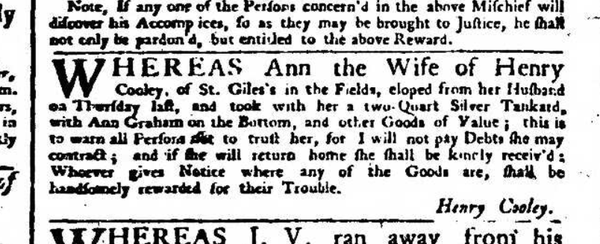
It’s obvious why husbands chose to make their news so uncomfortably public. At heart, it was damage limitation, though Mr Azier, watchmaker, seems to have been unlucky. He was pursued for a debt of £150 run up by his estranged wife for ‘Velvet, Damask Cloaths, Diamond Rings, Gold Watch etc’. On that occasion, the court ruled that ‘none in this case could justify the giving of credit to another man’s wife, for more than necessaries for food and apparel, but not for superfluities like those.’ (Caledonian Mercury 5 July 1725). For whatever reason, whether justified or not, Mrs Azier seems to have sought a way to punish her husband.
The AHS Women and Horology project is advancing our knowledge of the roles that women have played in the story of time. Do contribute if you can!
On the trail of a turret clock
This post was written by Dale Sardeson
Many readers will no doubt be aware of the Thwaites archive transcription and investigation project that James Nye and Keith Scobie-Youngs have been working on for the last few years.
As part of my own research into the turn-of-the-nineteenth-century Bond-Street watchmaking partnership Allam & Caithness, I asked James if he would look into the Thwaites documents for me and see what he could find pertaining to the pair.
I knew there was bound to be something, because in the Society of Antiquaries in London there is an Allam & Caithness table clock with a stamped Thwaites movement. I just didn’t know what or how much else the archive might reveal.
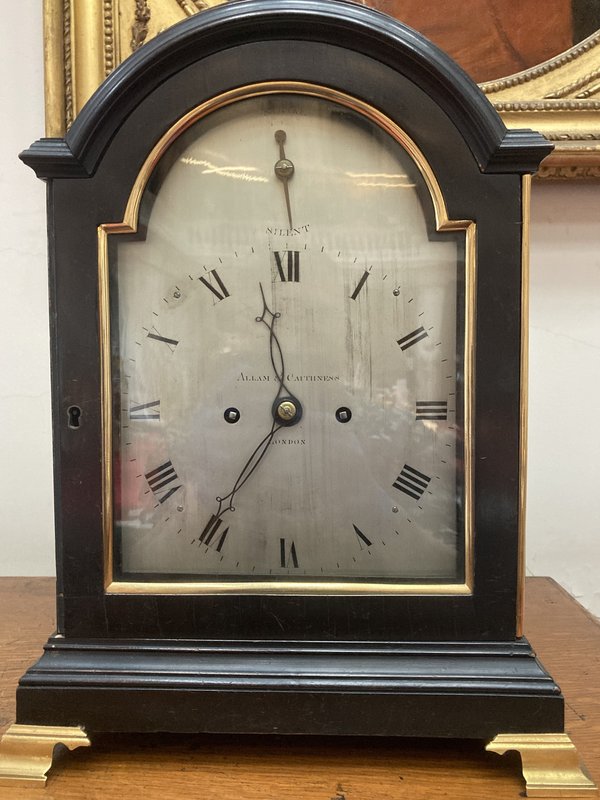
The period of daybooks that Keith and James have transcribed runs from 1780 to 1798, finishing three years after John Allam and Thomas Caithness went into partnership. With no Allam & Caithness entries in the daybooks for this period it appears that the pair did not have anything made for them by Thwaites during their first few years of trading, though unsurprisingly the partnership of William Allam (John’s father) and Thomas Clements did turn up a few entries in the transcribed period.
Undeterred though, James located a handful of pages from the Thwaites estimate book in the early 1800s pertaining to Allam & Caithness. All for turret clocks, among them was the following, dated September 1804, for an eight-day turret clock to be supplied for the Halsey Estate at Gaddesden Place in Hertfordshire.
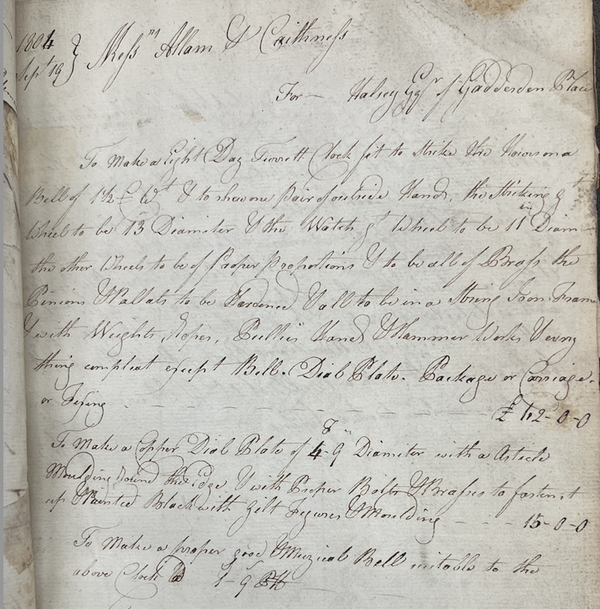
James kindly did a search of the turret clock database and found that an Allam & Caithness turret clock is in St. John-the-Baptist church in Great Gaddesden, just down the road from Gaddesden Place...
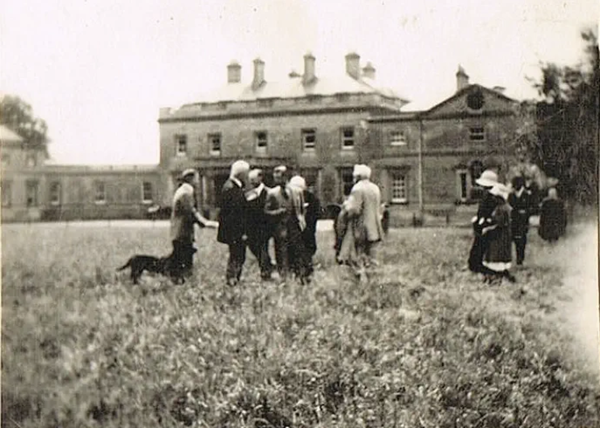
...so to Gaddesden we must go.
To be continued.
Time to count our blessings
This post was written by James Nye
On Thursday 11 July 2024, a band of ten AHS members joined an unusual service conducted by the Rt Revd David Urquhart, assistant curate at St Mary-at-Hill, the church opposite our headquarters at 4 Lovat Lane and the venue where our London Lectures are held. It was for the blessing of the church clock, well-known in the City of London in part owing to the angle at which it sits (with a pronounced downward tilt), now stabilised with recent engineering interventions.
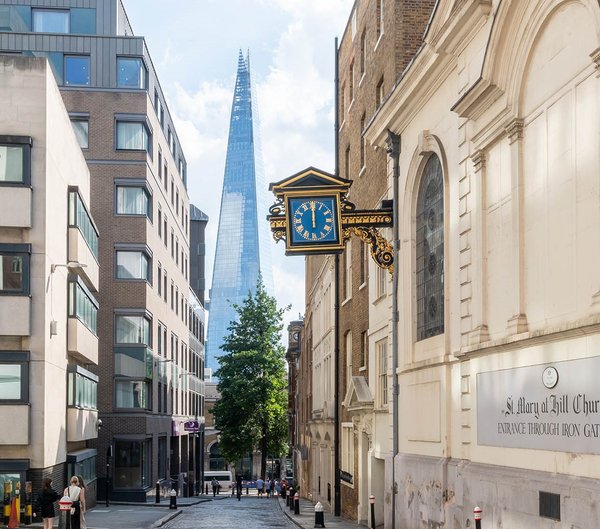
During 2023, the clock was scaffolded for some months to allow for conservation, new steel guyline supports, new leadwork, wood repairs, repainting, regilding, and more.
The church was rebuilt by Christopher Wren following the Great Fire, and survived the Blitz unscathed, but was severely damaged by a fire in 1988, after which its roof and ceiling required rebuilding. The original clock was possibly by John Wise, and the main external support timbers probably date from installation in the early 1670s. The clock gained a minute hand in the mid-1820s, but the original movement was later removed, perhaps in the mid-20th century, when a synchronous drive was installed. This reached the end of its life and was replaced in 2023 as part of the wider restoration project.

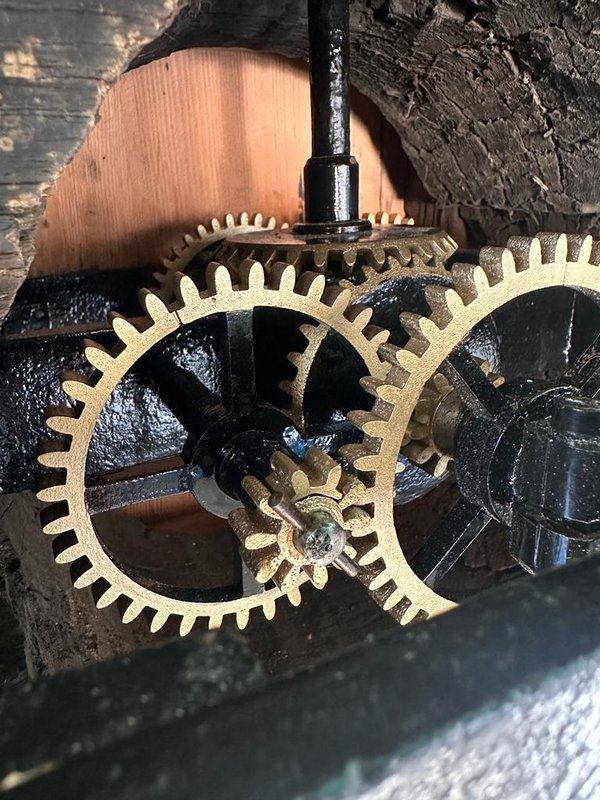
I visited the clock when Mark Crangle and Alex Jeffrey were finishing work for the Cumbria Clock Company. This included replacing the motor, fitting a new drive shaft, servicing the motion work and repainting the dials. There is a short film here
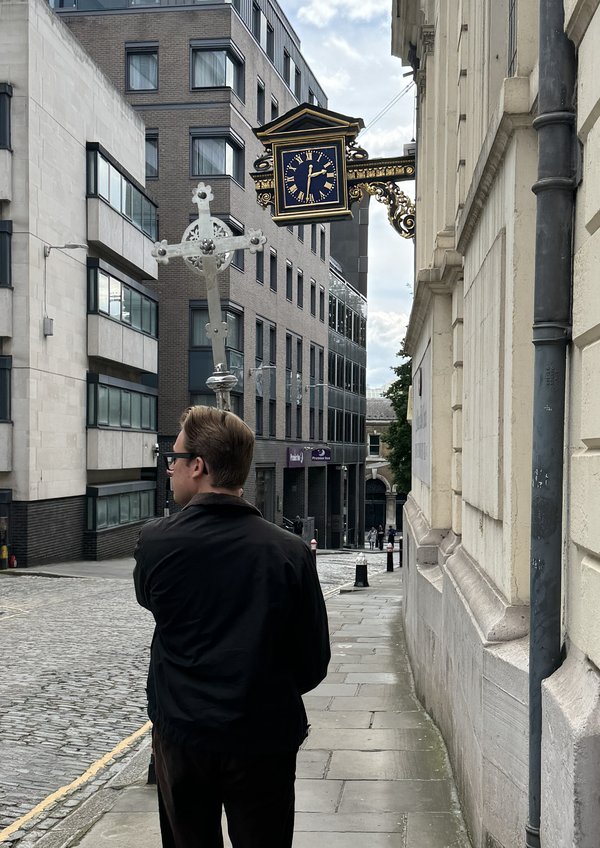
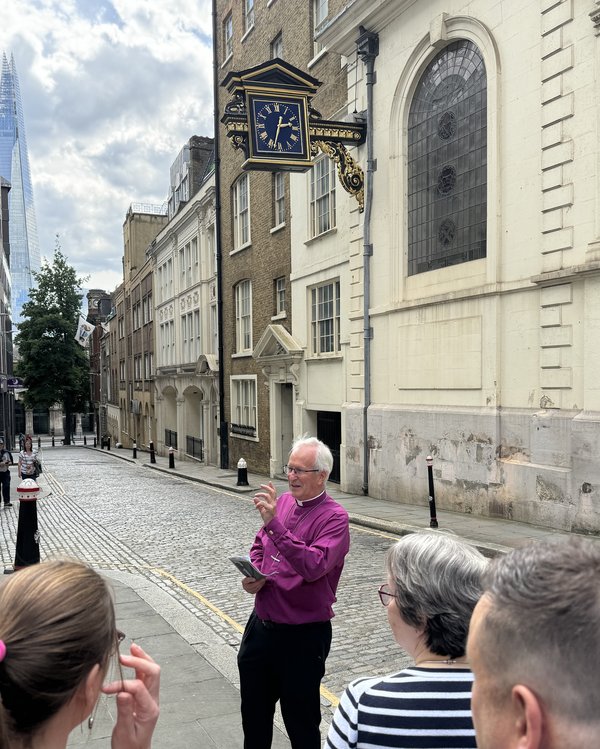
As we stood below the clock in the lovely afternoon sun, Revd David treated us to a reflection on the nature of time – the timelessness of much, yet the way there is so little time for anything when our lives are so frantic. He encouraged us to take to time to reflect, before leading a prayer for wisdom in using time, concluding with these words:
May this clock bring order to chaos and haste,
Mark joyous occasions and moments of grace.
Let it remind those who glance at its face
Of time’s precious gift, not a burden to chase.
We joined David and his fellow team members, plus priests from the local area, for a celebration back inside the church, where more photos of the clock restoration are on display – do take a look if you are passing by.
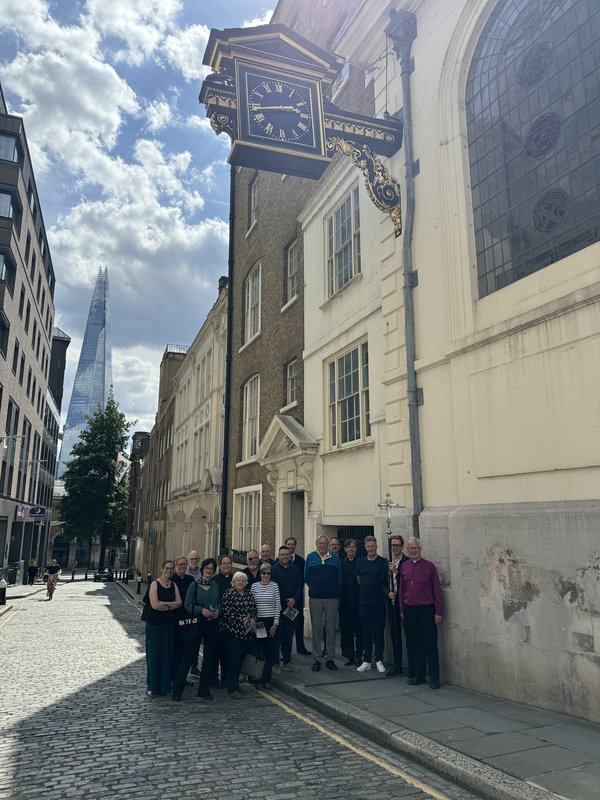
A time for sport
This post was written by James Nye
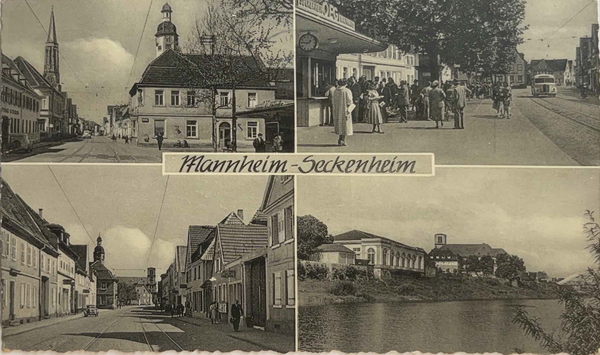
Since 2000, people have gathered each year in Mannheim-Seckenheim (Germany) one Spring weekend, ostensibly for an electrical horology fair, which over time has developed into a strongly social affair; a chance for distant friends to catch-up. In addition, a tradition has emerged for a small exhibition. This is the brainchild of one the two main organisers, Dr Thomas Schraven, known to many for his intense interest in, and knowledge of, the field of short-time measurement.
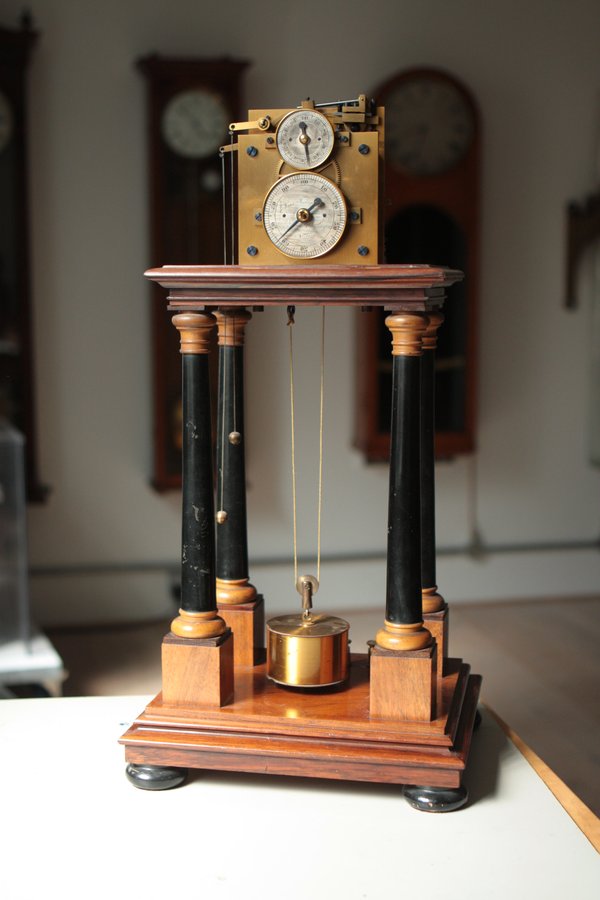
His research started with an in-depth exploration of the Hipp chronoscope, capable of measuring to 1/000th of a second, and used across many sciences. Much later his research into companies such as Löbner, Hammer and Zimmerman brought the uniquely German tertienuhr into sharp focus – a less expensive but useful device capable of measurements of 1/100th second.

Beyond the academic fields of science, short-time measurement has always been to the fore in sport, where records are established and determining close results may require the use of precision timing equipment. These days, it is easy to imagine all manner of electronic means for detecting and recording events, but a century ago the technology involved simpler analogue mechanics: the breasting of a tape in a race, the compression of a pneumatic hose below the tyres of a car, and so forth.
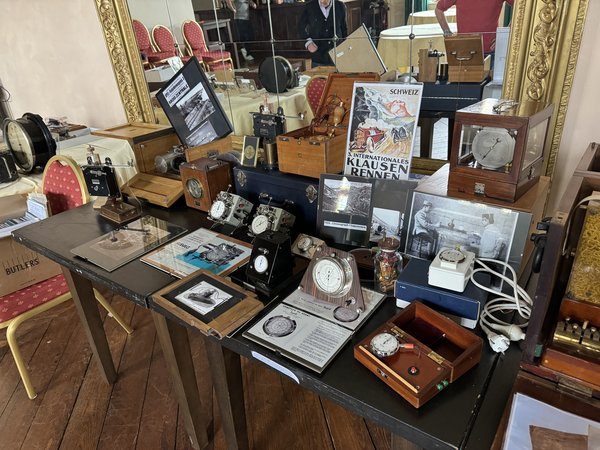
This year, Thomas mounted an exhibition centred around ‘Electromechanical Timekeeping in Automobile Racing’, including some pieces not seen in public before, and with the loan of a remarkable timing instrument from Stefan Muser of Dr Crott auctioneers.

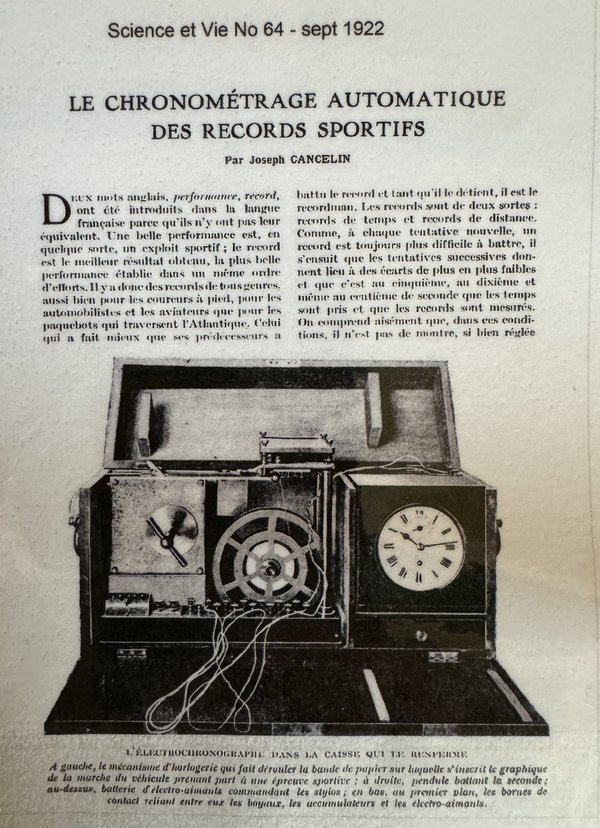
This was a racing chronograph made by Elliot Brothers from London, in its massive transport box. It belonged to the Automobile Club de France in 1922, and was featured in La Science et la Vie.

Other important timepieces were the chronograph by Henri Chaponnière, used in the 1924 Klausen Pass race, and the time-pressure registration chronograph by Löbner, as used in the record drives with Fritz von Opel's rocket car RAK 3.

This was a diverse exhibition. Off the automobile theme, and not expecting weaponry, we were momentarily surprised to see a modified 9mm Zoraki pistol coupled to a Hanhart stopwatch, and a most intriguing early twentieth century electric chronometer from d’Arsonval, with an accompanying image showing it in use, to test the reaction times of Great War French pilots.

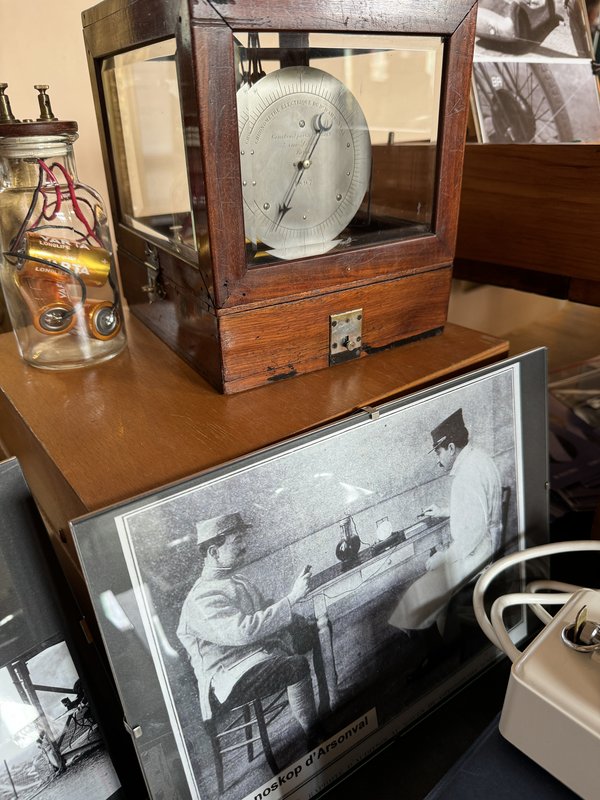
In all, a remarkable assembly of items one might spend a lifetime struggling to find in museum reserve collections, but gathered for the occasion and the great enjoyment of all present. (All photos by James Nye except where stated).
Christ transformed into an astronomer
This post was written by Peter de Clercq
As I have a special interest in historical scientific instruments, I was intrigued when I first saw this clock some twenty years ago in Somerset House in central London, overlooking the River Thames.
As far as I remember, the exhibition label did not comment on the figure of a man looking through a telescope, with a pair of dividers in his left hand and a globe at his feet. I was intrigued. The first telescope was developed in 1608. Could this be a very early representation of such an instrument in use?

Sir Arthur Gilbert and his wife Rosalinde formed one of the world's great decorative art collections, which he donated to Britain in 1996. Parts of it were on display in Somerset House from 2002 to 2008. After that, the collection was transferred on loan to the Victoria and Albert Museum, where a generous selection is on display in Gallery 70.
And here I saw the clock again, and learned something I had failed to understand when I first saw it.
The silver-gilt, ebony and ivory clock of architectural form, 76.5 cm high, is a combination of a shrine and a table clock, both made in the seventeenth century but assembled into the current configuration in the late nineteenth century, probably in Berlin. The clock is signed on the dial and the backplate by Elias Kreittmayer (1639–1697), a clockmaker working in Friedberg in Germany, while the shrine is ascribed to the Augsburg goldsmith Matthias Walbaum (1554–1632).
As the gallery label states ‘Made to appeal to specialist collectors, the shrine’s original Christian nature can still be seen in the figure with a telescope (above the dial), who was adapted from a representation of Christ. Such transformations are masterpieces in their own right.’
So the miniature telescope was not as old as I had thought.
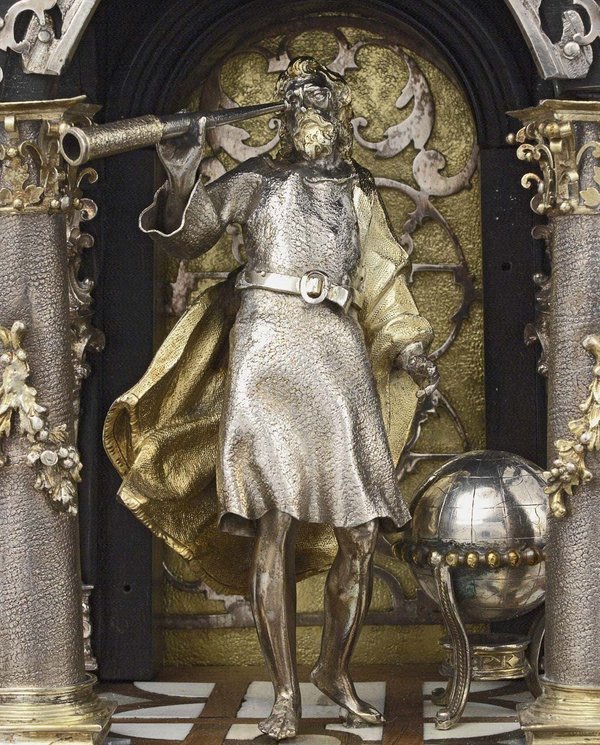
There is a sobering story connected to the clock. One of its previous owners was Nathan Ruben Fränkel (1848–1909), a Jewish clockmaker from Frankfurt who built up an encyclopaedic collection of timepieces. It is not known what happened to this clock after his death and in the years before it resurfaced in 1975. And this uncertainty is alarming because of the extent of persecution experienced by his family.
Friedrich and Klara Fränkel, who ran a thriving watch business in Frankfurt, were forced into bankruptcy by the Nazis. In 1938, they fled to France where they narrowly escaped deportation and survived the war in hiding.
The clock has formed part of a special provenance display in the V&A 'Concealed Histories: Uncovering the Story of Nazi Looting' (December 2019–June 2021).
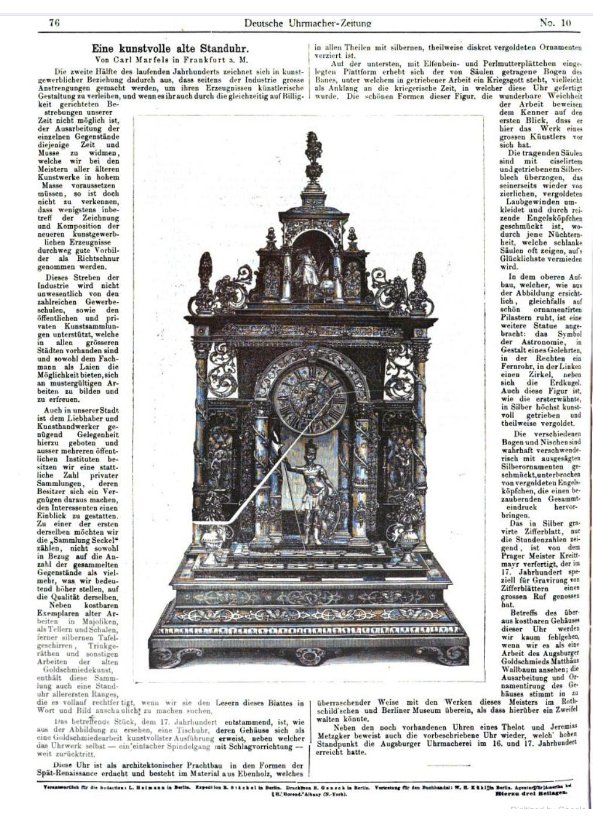
Let’s end on a more uplifting note.
In 1890, the German clock collector Carl Marfels (1854–1929) presented the clock in the Deutsche Uhrmacher-Zeitung, the journal for clock- and watchmakers. His article is illustrated with a photo on which the telescope and the globe can clearly be seen. Marfels does not seem to have realised that the object had been doctored with. He concludes: ‘[…] the clock is yet another proof of the high standard of clockmaking in Augsburg in the 16th and 17th centuries’.
If it were indeed original, the clock would have contained a very early representation of a telescope — but we now know better.
A version of this blog post was published in the Bulletin of the Scientific Instrument Society, No 160 (March 2024), p. 19.
A deadly wind up
This post was written by James Nye
Horology is rarely gruesome, but on this occasion it certainly was. One of the largest and most impressive Gillett & Johnston clocks was installed in the Royal Courts of Justice in 1883. Its commissioning was accompanied by much pomp and ceremony, duly recorded on 29 December in the Illustrated London News.
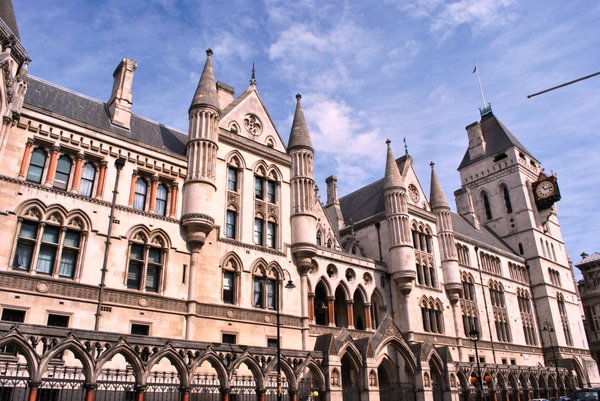
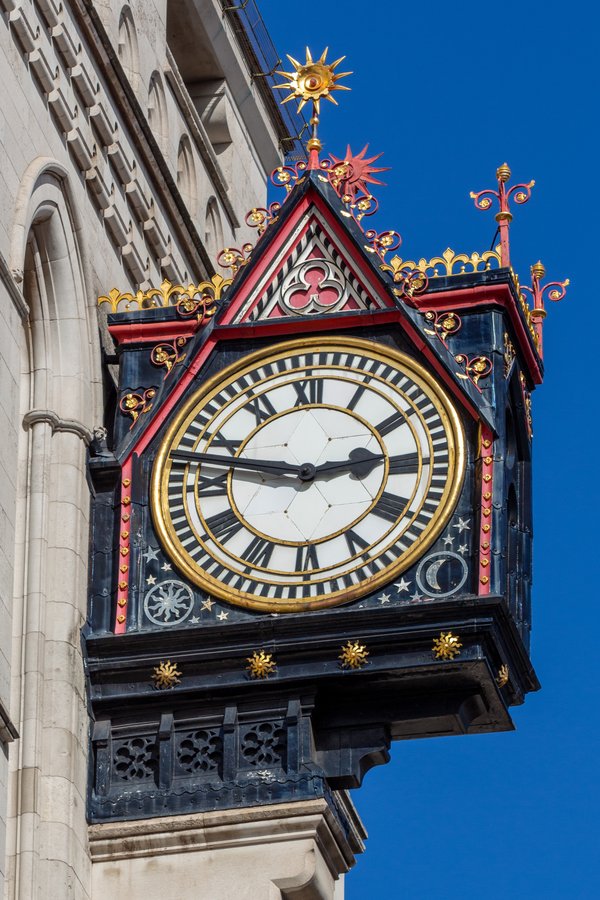
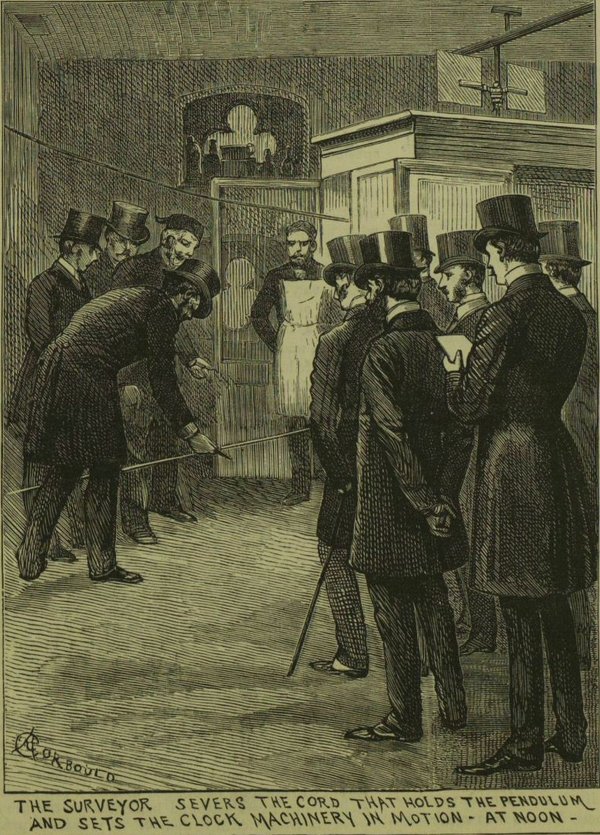
The mechanism utilises a double-three-legged gravity escapement together with a remontoire, capable of excellent timekeeping.
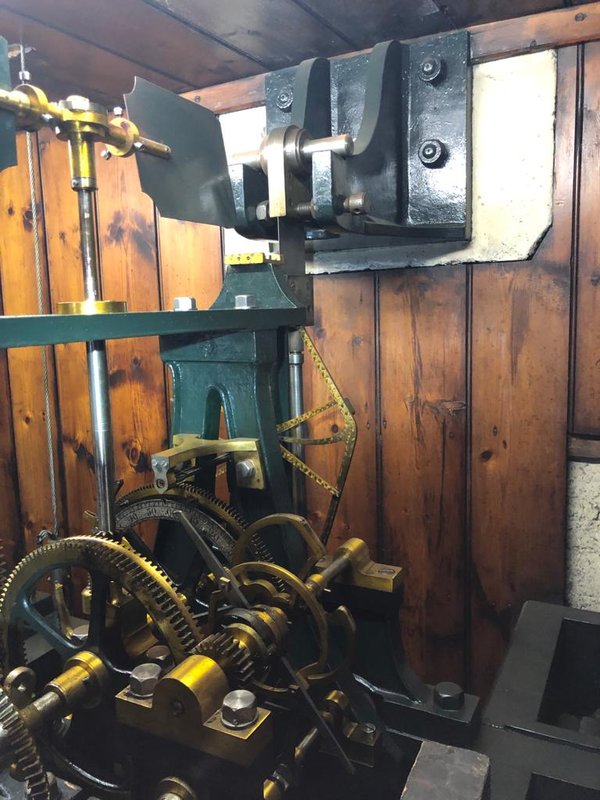
Gillett’s were certainly irritated in May 1893 by a correspondent in the Horological Journal suggesting their clock had wandered by 15–30 seconds per day in mid-1892. They published their own record, showing frankly astonishing accuracy.
The clock will have involved a significant amount of labour to wind by hand, and unsurprisingly an electric winding motor was added later. The date of the motor remains unknown but it could well be the one shown here.
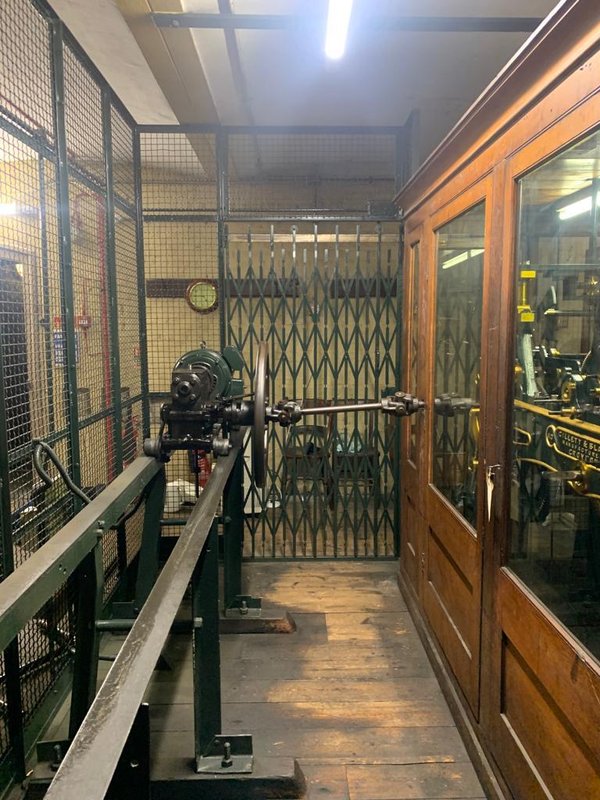
It sits on a twin railway track, which runs laterally in front of the movement, and on which the motor is moved opposite each of the three winding arbors in turn, engaged, and then energised to perform the winding of the weights.
The winding round at the Royal Courts has always involved hundreds of smaller clocks, as many as 800 at one time, as well as the large clock. In 1937, the 25-year-old Tommy Manners took over the job, and settled into a long-established routine, touring the whole complex, with a once-weekly visit to the tower to wind the big clock.
This lasted through the 1930s, through the Second World War, into the sunlit uplands of the 1950s, until the morning of Guy Fawkes’ Day 1954. Around 9am on 5 November, Manners climbed to the tower as usual. He was under notice not to get too close to the flywheel when winding was underway, but somehow his dustcoat was caught, the fabric becoming quickly wound tight. He was trapped, unable to escape, and if he cried out, no-one heard above the roar of the traffic below, as the clock motor, anaconda-like, squeezed the life out of him.
Something else not heard was the strike of the clock, resulting in two engineers climbing to the clock room some 90 minutes later to find out why. Somehow, Manners had become freed from the motor, and was lying beside it. Rapid first-aid was to no effect, and he was transferred to Charing Cross hospital, but in vain.
An inquest at Westminster a week later recorded a verdict of accidental death, noting that Manners had been alerted to the risks posed by the flywheel. One outcome of the tragedy was the fitting of the serious safety cage around the whole mechanism, visible in the accompanying image. A modern micro-switch arrangement now prevents the motor being operated except at a distance.
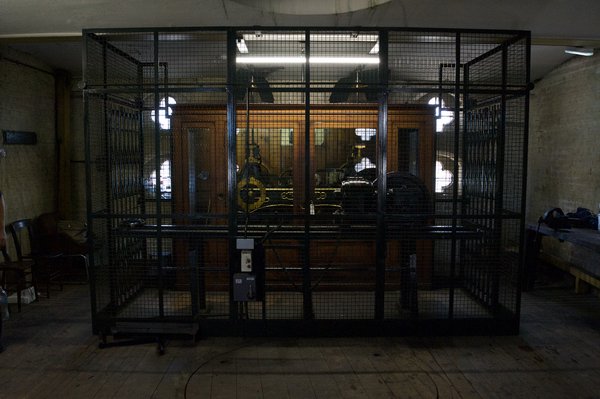
The original news caught the attention of many a newspaper editor round the world. Both the Guardian (6 November) and The Times (13 November) covered the incident. The Sarasota Herald (6 November) ran the story with the dramatic headline, ‘Clock Winder is Killed by his Favorite Clock’.
A sobering tale.
The last piece of the jigsaw: a relatable story for researchers
This post was written by Su Fulwood
Research is, of course, interwoven through my work. One long-term project is about women and their roles in horology. This started when I was working with watchmaker Geoff Allnutt in his shop and workshops at 8 West Street, Midhurst. Geoff challenged me to go through lists of watch and clockmakers to note down all the women mentioned. After finding hundreds of women among the men, one name stood out: 'Mary Ann Lawrence, West Street, Midhurst'.
A quest began in earnest to find out where in the street Mary Ann had worked.

Years have passed and our research has covered many individual women, including, gradually, lots about Mary Ann. We discovered that she was actually from a well-known family of local watchmakers, the Wrapsons. We found that she took over her brother's premises in West Street following his death. We also discovered that she was close friends with fellow watchmaker, Joseph Charles Ketterer.
Ketterer, we knew with certainty, had run his business until 1914 from the premises Geoff now occupies.
We couldn’t say, however, whether Ketterer took over from Mary Ann or whether she had worked from another shop. It wasn’t uncommon in Midhurst for there to be two watchmakers in the same street at a similar time.
We did know Mary Ann retired around 1895, and that Ketterer was the executor of her will when she died. We just didn't have that last all-important piece that would tell us if she was part of the history of 8 West Street. It was frustrating.
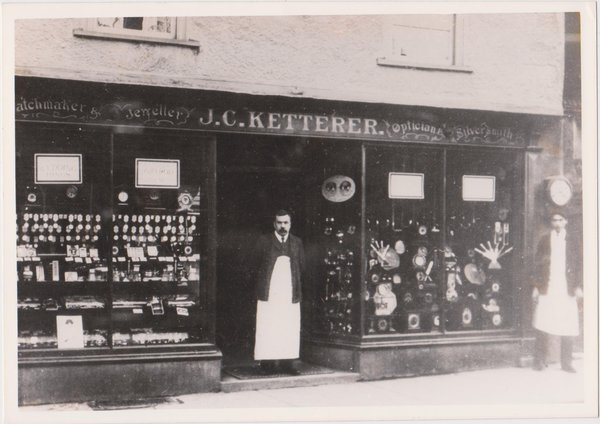
Until now that is ... seven years later, when a chance conversation revealed the existence of a different advert for Joseph Charles Ketterer’s business.
When we saw it we couldn’t believe our eyes. There at the top, unexpectedly, was exactly the information we had been looking for. The words 'J. C. Ketterer (Late Lawrence)' were pure gold for us. It meant that Mary Ann Lawrence (who describes herself as 'Mistress Watchmaker' in the 1881 Census) was running her watchmaking business from the shop before Ketterer. This also meant that the same premises had belonged to her brother Charles Wrapson and, before him, their mother, Mary Wrapson.
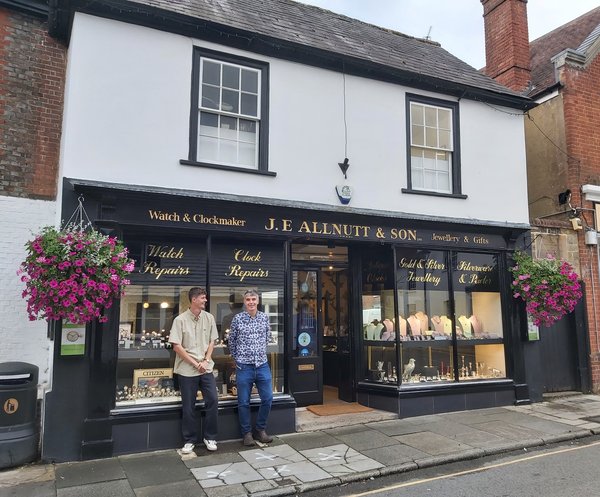
Our research began by looking at watchmaking women across the country. But it has become very personal, as finally we were able to show that two of those women inhabited the exact spaces we work from today.
In the meantime, along with my research about women and horology, I get to work with other women today, as more are attracted back to watch and clockmaking.
The tools are important too
This post was written by Seth Kennedy
Many horological workshops contain old tools. It seems to go with the territory. There is something about using a hand tool that has already been around for a century or more. It brings questions, wondering whose hands have previously worked with this object over several generations and what timepieces were they working on?
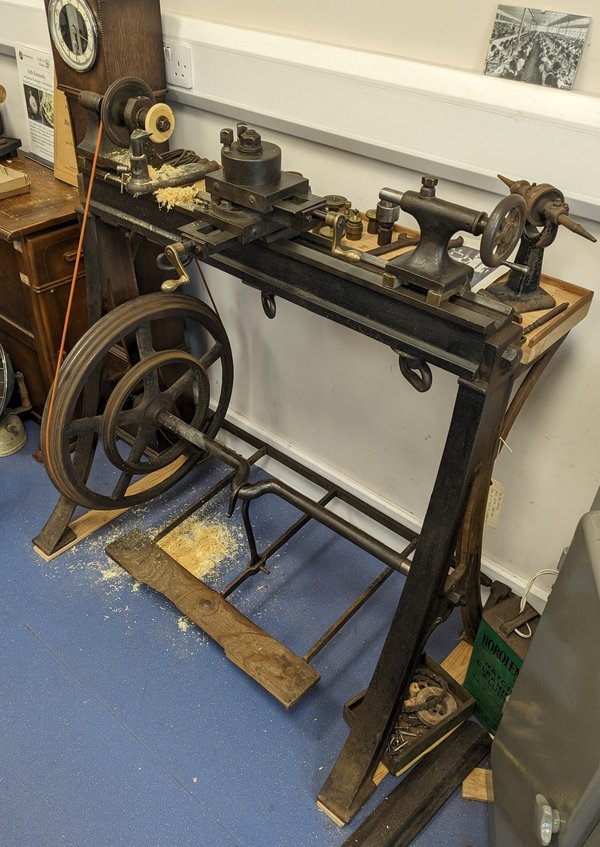
With thanks to a fellow restorer, I recently became custodian of something a bit larger than a saw or a file. It’s a plain lathe by Pfiel most likely made in the late 19th century. Pfiel & Co were tool makers and retailers with a large shop and warehouse on St John Street in Clerkenwell. There are a few details about these lathes that make them distinguishable and so it is possible they were actually cast and machined in London to Pfiel specifications.
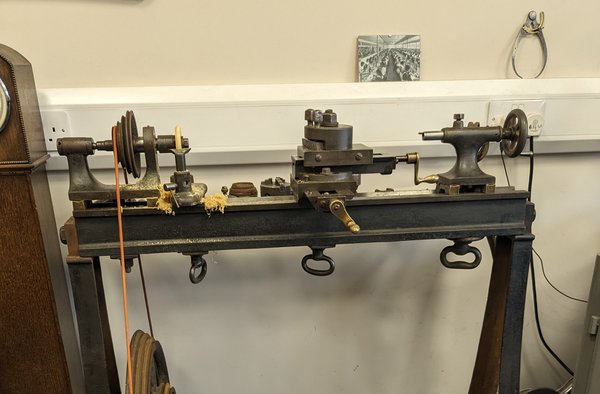
The centre height of the spindle is 3.5”, or at least it was, since on this example some home-made brass spacers have been added under the head and tailstock so that larger parts could be turned. These spacers fit the flat front and veed back surfaces of the lathe bed.
The treadle board itself is an incredible survivor, showing its wear of a century of use. Also remaining, though unusable, is a very old gut line that was previously used to connect flywheel to spindle.
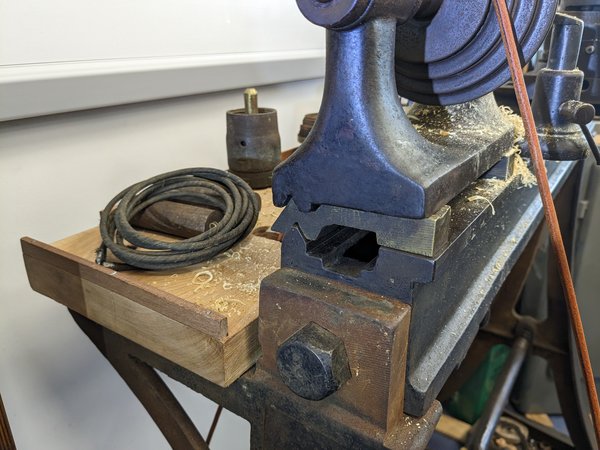

What makes this lathe particularly special is that its history is known. It came from the workshop of Daniel Parkes, a fourth generation clockmaker/restorer who was active in Clerkenwell until retirement in 1989. He was a founder member of the AHS and some of his tools are on display in the museum of The Worshipful Company of Clockmakers. Parkes used only traditional equipment and methods in the restoration of fine English clocks of the 17th and 18th century golden age.

The lathe could have come from his family’s workshop on Spencer Street, which was destroyed by a V1 bomb in June 1944 but from which he salvaged some equipment. Or it might have already been in the workshops that Parkes then moved to on Brisset Street, where a partnership was formed with A. & H. Rowley, also a firm with long Clerkenwell roots.
Either way, someone in one of those businesses needed a lathe in around 1890 and so walked down the road to the Pfiel shop and bought this one. After Parkes’s retirement it went to Mike McCoy, then to Matthew Hopkinson and then recently to my workshop.
It has now had some cleaning, oiling, a hidden strengthening plate added to the treadle, a new leather belt fitted and a new shelf added as the original had gone missing.
Tools are meant to be used and so, after perhaps 30 years of slumber it will now occasionally be put into action again, for turning boxwood chucks used in watch case making and other light tasks.
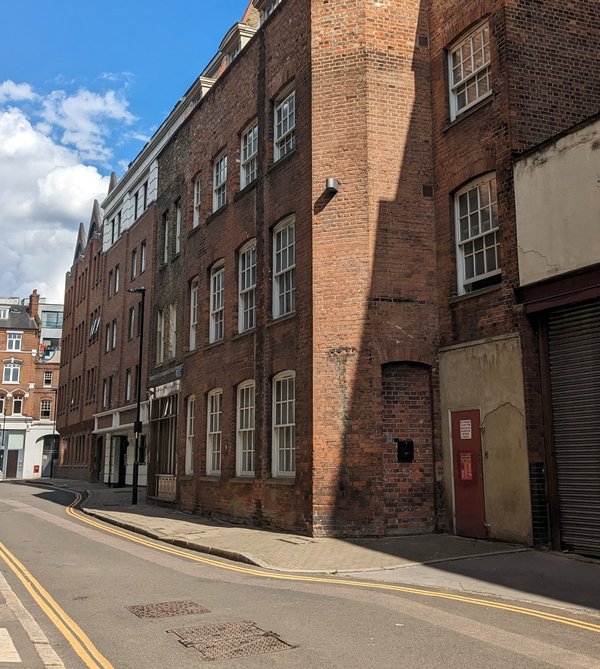
Backwards and forwards
This post was written by James Nye
I am shocked to realise it is now a decade since I blogged about Enicar watches. As collectors know, Enicar derives from reversing the family name of the owners, Ariste and Emma Racine. Signing clocks and watches like this has a long tradition, with an interesting variety of explanations.
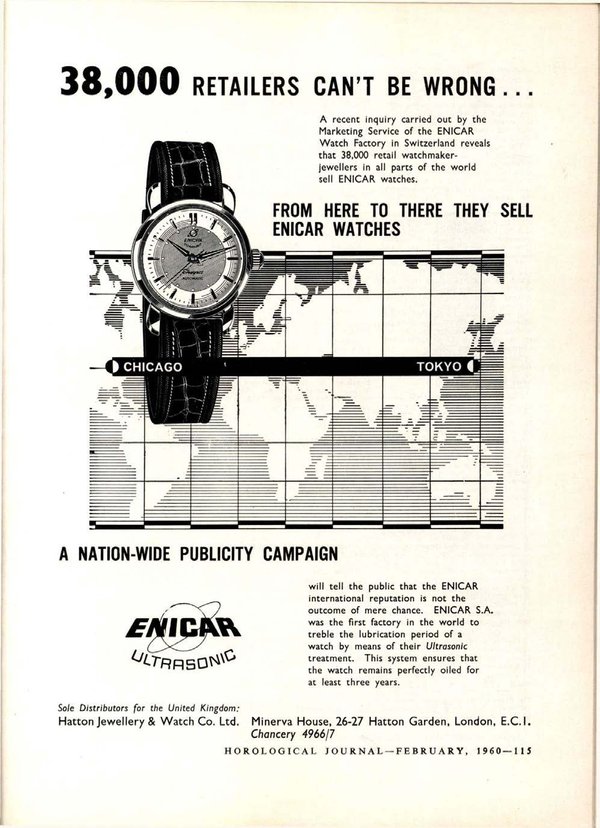
Back in the December 1993 issue of Antiquarian Horology, Sebastian Whitestone discussed some watches that bogusly claimed a London origin, but which in reality were from the Friedberg region and signed Lekceh, Legeips, Rengaw, Renpuarg and Ysorb. Reverse these and we have the less exotic Heckel, Spiegel, Wagner, Graupner and Brosy.
Mirrors reverse images, and tellingly, Spiegel also used the giveaway signature Miroir, London. The word ‘spiegel’ is German for mirror, and thus another pun.
But not all Friedberg makers reversed their names when they added a London location. Eckert and Schreiner signed (falsely) from London, but used their normal names.

Surveying the Ashmolean Museum's watches in the December 2000 issue of AH, David Thompson enlarged the geography, tying a watch signed ‘Renpuarg, London No. 4’ to Augsburg.
Alice Arnold Becker revisited backward signatures in AH in June 2014, taking the line that it was all marketing. The watchmakers perhaps falsified locations to secure the gravitas and caché of the London market – creative branding, familiar today.
Dutch horologist John Selders has also studied this phenomenon, publishing several pieces in Tijdschrift and summarising in 2015 with a list of 24 such reversed names, from the late seventeenth century to the turn of the nineteenth, and noting that some makers signed from Paris, not just London.
Strangely, precisely the same thing happened in Britain. English and Scottish makers of watches also reversed their names. An example is a watch by James Peddie of Stirling, signed on the back plate Jas Eiddep (see Clocks, April 2019). More prolific is Eardley Norton, whose signature Yeldrae Notron appears with surprising frequency. Usher & Cole’s apprentice John Wontner later signed objects as Rentnow. Cole signed as Eloc.
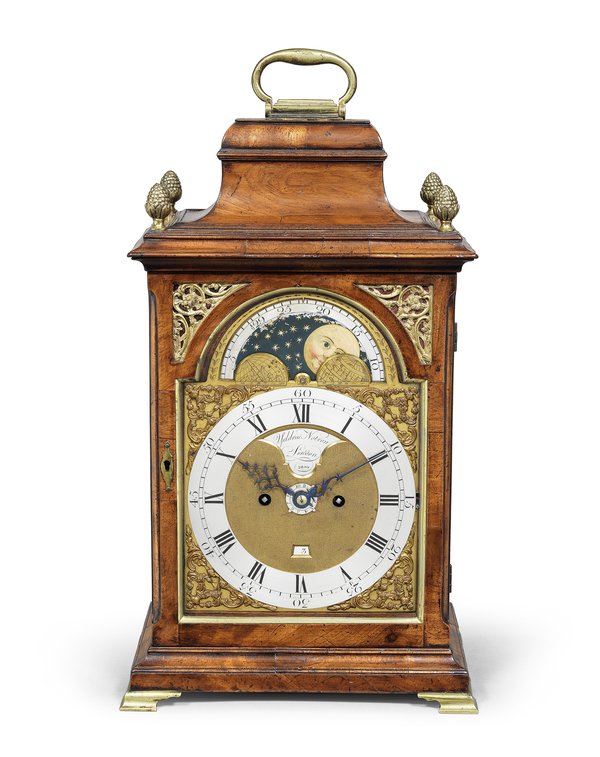
What on earth were all these people doing? There are several theories. Some assume distant makers wanted to capture borrowed prestige, and value, by signing from London, or Paris – an element of passing-off. A false signature disguises true authorship.Some suggest it was done to avoid taxes. Perhaps it limited redress to a real maker. Or perhaps it shows the maker’s sense of humour?
Does it all echo the original Rolex/Tudor division – an affordable product from the same stable, but differentiated?

No firm conclusions are possible, but some theories are surely too far-fetched. Tax officials won’t be fooled by mirror-writing. Signing a watch carries a maker’s chosen identity out into the world, and should be permanent, and memorable. A sense of whimsy could be involved, maybe even a sense of a brand that stands on its own, distinct from the name of the controlling mind involved.
In all, a subject that deserves more than a backwards glance... and if anyone has any other examples of reversed clock and watch signatures, please do tell me!
The watches of Samuel Pepys
This post was written by Peter de Clercq
The office of the AHS in Lovat Lane in the City of London is a stone’s throw away from The Monument, erected to commemorate the Great Fire of London of 1666.

The fire was famously reported in The Diary of Samuel Pepys (1633–1703), which ‘is unique, no less for Pepys’s self-revelation, than for its graphic picture of social life at the time of the Restoration’. This is a quote from the preface in my copy of the Library of Classics edition first published in 1825. Running to 640 pages, it yet contains scarcely half of the manuscript. It had also been ‘suitably edited’, which perhaps means that for example anything to do with his bodily functions or his amorous exploits had been removed.
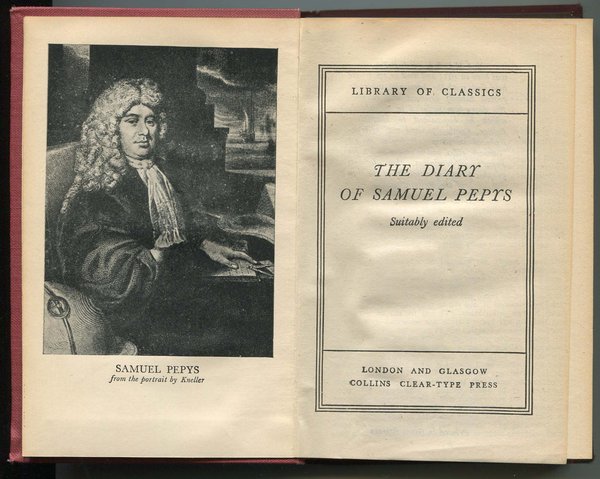
A more complete edition appeared in 1893, and this forms the basis for a magnificent website which offers ‘the full text of his diary, along with several letters sent or received by Pepys, plus thousands of pages of further information about the people, places and things in his world’.
It is searchable, and if you want to find out what Pepys wrote about clocks and watches, you will find some two dozens entries.* Let’s follow one trail, all to do with watches:
Monday 17 April 1665: 'This day was left at my house a very neat silver watch, by one Briggs, a scrivener and sollicitor […].'
Friday 12 May 1665: 'To the ’Change [the Royal Exchange] and thence to my watchmaker, where he has put it [i.e. the watch] in order, and a good and brave piece it is, and he tells me worth 14l. which is a greater present than I valued it.'
Saturday 13 May 1665: 'To the ’Change after office, and received my watch from the watchmaker, and a very fine [one] it is, given me by Briggs, the Scrivener. […] But, Lord! to see how much of my old folly and childishnesse hangs upon me still that I cannot forbear carrying my watch in my hand in the coach all this afternoon, and seeing what o’clock it is one hundred times; and am apt to think with myself, how could I be so long without one; though I remember since, I had one, and found it a trouble, and resolved to carry one no more about me while I lived.'
Wednesday 13 September 1665: 'Up, and walked to Greenwich, taking pleasure to walk with my minute watch in my hand, by which I am come now to see the distances of my way from Woolwich to Greenwich, and do find myself to come within two minutes constantly to the same place at the end of each quarter of an houre.'
Friday 22 December 1665: 'I to my Lord Bruncker’s, and there spent the evening by my desire in seeing his Lordship open to pieces and make up again his watch, thereby being taught what I never knew before; and it is a thing very well worth my having seen, and am mightily pleased and satisfied with it.'
Saturday 22 September 1666: 'My Lord Brunck […] now give me a watch, a plain one, in the roome of [instead of] my former watch with many motions which I did give him. If it goes well, I care not for the difference in worth, though believe there is above 5l.'
All this is very interesting, but it leaves questions unanswered.
Why was Pepys given a watch 'by one Briggs, a scrivener and sollicitor', about whom we hear no more in the diary, and who is not mentioned in Claire Tomalin’s excellent biography published in 2002? Did he want to curry favour with Pepys, perhaps hoping to benefit somehow?

We are not told the name of the man who had serviced his watch, nor do we have details of the watch except that it was worth £14 and came 'with many motions', which we take to mean that it not just showed the time but also had additional functions that could make a watch such an attractive possession.

But why, we may ask, had Pepys earlier in his life been so frustrated with a watch? Had it malfunctioned?
His wife had her own watch (Saturday 9 February 1666/67: 'This noon come my wife’s watchmaker, and received 12l. of me for her watch') but it led to irritation (Wednesday 3 April 1667: ‘and to bed, vexed … that my wife’s watch proves so bad as it do').
Or had it been the anxiety that a watch could draw unwanted attention, like we hear these days of brutal daylight robberies of expensive watches? On Wednesday 1 January 1667/68, Pepys ‘took coach and home about 9 or 10 at night, where not finding my wife come home, I took the same coach again, and leaving my watch behind me for fear of robbing, I did go back.’
If he was so taken with his fancy watch that he could not stop consulting it when he set out with it in his coach, why did Pepys later give it away to William Brouncker (c. 1620–1684), and accepted a simpler and less valuable one in return?
Lord Brouncker was from 1662 to 1677 the first president of the Royal Society, an office to which Pepys himself was to be appointed in 1684, long after he had stopped writing his diary.
Brouncker features prominently in Pepys’s diary; they were neighbours and on friendly terms. So perhaps Pepys gave him his fine watch simply from the goodness of his heart, and that is a nice note to end on.
* Searching on ‘clock’, one must weed out hundreds of 'o’clocks', and ‘watch’ is of course often found to mean ‘look at’, but with some patience I found 23 pertinent entries which I shall be happy to share with anyone interested.
Ringing in the New Year
This post was written by Andrew Strangeway
As a clockmaker, or practising horologist, there is one particular moment while waiting for a clock to strike when time seems to slow down.This moment is more daunting when the streets outside are lined with 100,000 people and millions more are watching live on television, and streaming, waiting to hear the clock chime.
On December 31st it all comes down to a single moment, when the nation watches and waits for Big Ben to ring out and signal the start of the new year. Behind the scenes, however, months of preparation go into ensuring that this first hammer-blow falls precisely on time. Besides the installation of additional broadcast equipment, regular servicing, and thrice weekly winding there is also timekeeping: ensuring, literally, that the clock stays on time.
In the months leading up to the end of 2023, the timekeeping of the Great Clock was a core focus. After the break of six years during the servicing of the clock and tower, the twice-daily live chimes finally returned to BBC radio airwaves on November 6th. This New Year marked the 100th anniversary since the bells were first broadcast live for New Year’s Eve. It was a matter of pride that the clock should perform well and strike on time.
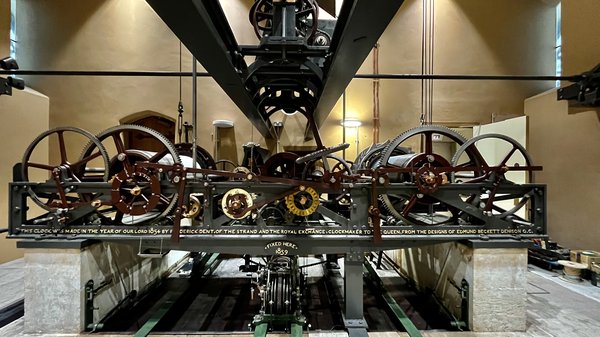
When it was first installed, the Great Clock was, by some margin, one of the most accurate public clocks in the world. The original specification for the clock set down in 1846 by George Airy, the Astronomer Royal, required that ‘the striking machinery be so arranged that the first blow for each hour shall be accurate to a second of time’. As clockmakers our job is to ensure that the clock remains true to this original purpose. To our advantage, we have highly accurate timekeepers to compare the Great Clock against and, armed with this information, we can regulate the pendulum carefully and actually comfortably exceed the original target for accuracy.
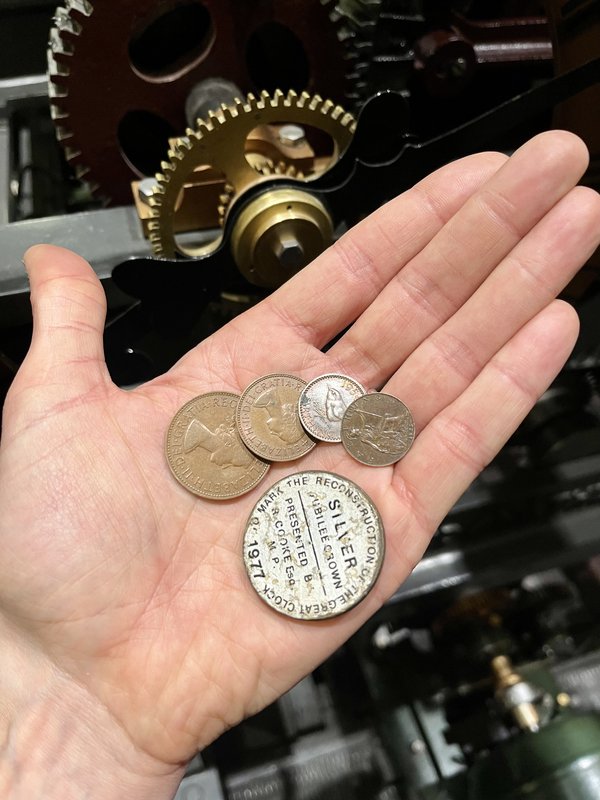
Since starting at the Palace of Westminster in August 2023, I have implemented the use of a new custom-made timer to increase the accuracy of the timing of the first hammer-blow of the hour and an improved regimen of regulating the rate of the clock’s pendulum. The core mechanics of regulation remains as ever: the placing or removing of weights, in the form of old currency, on a small platform partway down the length of the pendulum rod. Famously, one pre-decimal penny added speeds up the clock by about 2/5th of a second over 24 hours. These are a little too weighty and the adjustment too coarse if one is aiming for a finer degree of accuracy. I have begun using ha’pennies and farthings for regulation, kindly lent for the purpose by my colleague in the clock team, Ian Westworth. These speed the clock up by about a quarter of a second a day and a tenth of a second a day respectively.
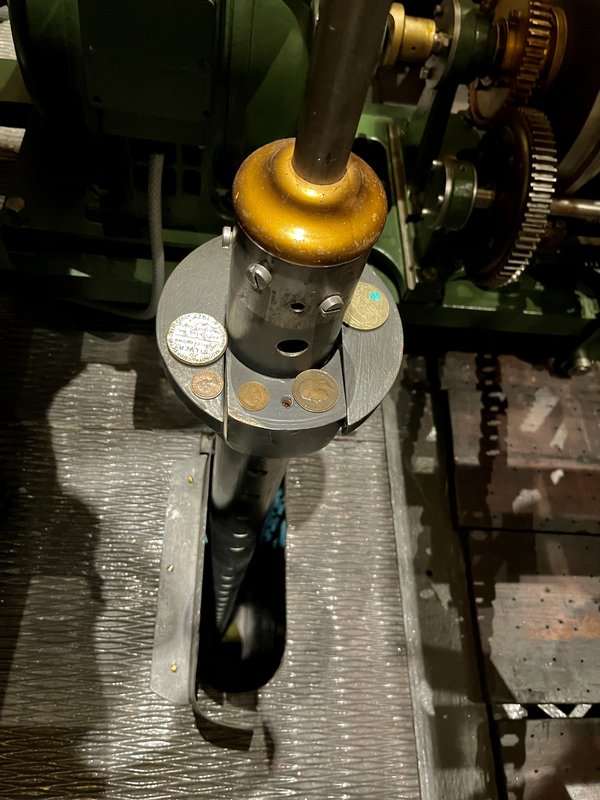
In the final days running up to New Year’s Eve I was at the top of the tower, on the hour, throughout the day to take a timing reading from the strike and to make small adjustments to bring the clock precisely to time. As luck would have it, on the evening of the 30th we experienced heavy winds, which buffeted the tower and were enough to throw the clock out by 0.2 seconds by the morning of New Year’s Eve. I was able to correct for this by the evening. Midnight came and Big Ben struck, and the view of the fireworks from the top of the Elizabeth Tower was astounding. It was awesome to see the fireworks perfectly synchronised with the strike of the bell.

My timekeeping efforts were rewarded when we measured the timing of the strike from the sound recording compared with a GPS clock – these results were generously provided by Mark Powell of DeltaLive. The result was that Big Ben struck midnight at exactly 23:59:59.981, within less than a fiftieth of a second of midnight. That’s less than a fifth of the time it takes to blink your eyes. I must confess to being rather pleased with that!

